Pricing Guides & Dictionary of Makers Marks for Antiques & Collectibles

A few examples of appraisal values for
THE NEW YORKER
Search our price guide for your own treasures
-
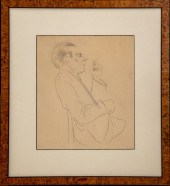 ARTHUR GETZ STYLE "MAN SMOKING"
ARTHUR GETZ STYLE "MAN SMOKING" GRAPHITE ON PAPER Arthur Getz (American, 1913-1996) style "Man Smoking in Profile" Graphite on Paper. Image: 10" H x 8.5" W; frame: 16.75" H x 15.25" W. Provenance: From a 140 East 56th Street estate. Keywords: Pencil drawings, Works on paper, Art Deco style, Cartoon, Illustration, The New Yorker
ARTHUR GETZ STYLE "MAN SMOKING"
ARTHUR GETZ STYLE "MAN SMOKING" GRAPHITE ON PAPER Arthur Getz (American, 1913-1996) style "Man Smoking in Profile" Graphite on Paper. Image: 10" H x 8.5" W; frame: 16.75" H x 15.25" W. Provenance: From a 140 East 56th Street estate. Keywords: Pencil drawings, Works on paper, Art Deco style, Cartoon, Illustration, The New Yorker -
 2VOL CHARLES DICKENS IN THE NEW
2VOL CHARLES DICKENS IN THE NEW YORKER, 1840/1841 Two complete volumes of "The New Yorker" volumes number 9 and 11, with volume 9, #1- 26, running from 3/21/1840 TO 9/12/1840 with #9 containing the American serialization and first appearance of "Master Humphrey's Clock" and the "Old Curiosity Shop" and with volume #11, #1-26 running from 3/20/1841 to 9/11/1841 with #11 containing "Barnaby Rudge." This was the American serialization and the first American appearance of "Barnaby Rudge." Both bound in leather with marbled paper overlays.
2VOL CHARLES DICKENS IN THE NEW
2VOL CHARLES DICKENS IN THE NEW YORKER, 1840/1841 Two complete volumes of "The New Yorker" volumes number 9 and 11, with volume 9, #1- 26, running from 3/21/1840 TO 9/12/1840 with #9 containing the American serialization and first appearance of "Master Humphrey's Clock" and the "Old Curiosity Shop" and with volume #11, #1-26 running from 3/20/1841 to 9/11/1841 with #11 containing "Barnaby Rudge." This was the American serialization and the first American appearance of "Barnaby Rudge." Both bound in leather with marbled paper overlays. -
 BOUND OFFPRINTS ON SYPHILIS &
BOUND OFFPRINTS ON SYPHILIS & 9-11 MEMORABILIA Comprising a collection of about 45 offprint of journal articles produced by staff at the Johns Hopkins Syphilis Department, 1931-'35; large 8vo, cloth. Together with issues of the New Yorker, Sept. 21, 2001, Sept. 13, 2021, and the NY Times Magazine, Sept. 23, 2001.
BOUND OFFPRINTS ON SYPHILIS &
BOUND OFFPRINTS ON SYPHILIS & 9-11 MEMORABILIA Comprising a collection of about 45 offprint of journal articles produced by staff at the Johns Hopkins Syphilis Department, 1931-'35; large 8vo, cloth. Together with issues of the New Yorker, Sept. 21, 2001, Sept. 13, 2021, and the NY Times Magazine, Sept. 23, 2001. -
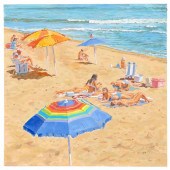 DAHL TAYLOR (NEW YORK, 1954-),
DAHL TAYLOR (NEW YORK, 1954-), BEACH SCENE., OIL ON CANVAS BOARD, 12" X 12". UNFRAMED.DAHL TAYLOR, New York, 1954-, Beach scene. Signed lower right "Dahl Taylor". Dimensions: Oil on canvas board, 12" x 12". Unframed. Provenance: Notes:A professional illustrator by trade, Dahl Taylor's work has been published in numerous periodicals, including Money , Forbes and the New Yorker . He is also a noted marine artist with several one-man shows on his CV, including one at the Maritime Gallery at Mystic Seaport, Connecticut.
DAHL TAYLOR (NEW YORK, 1954-),
DAHL TAYLOR (NEW YORK, 1954-), BEACH SCENE., OIL ON CANVAS BOARD, 12" X 12". UNFRAMED.DAHL TAYLOR, New York, 1954-, Beach scene. Signed lower right "Dahl Taylor". Dimensions: Oil on canvas board, 12" x 12". Unframed. Provenance: Notes:A professional illustrator by trade, Dahl Taylor's work has been published in numerous periodicals, including Money , Forbes and the New Yorker . He is also a noted marine artist with several one-man shows on his CV, including one at the Maritime Gallery at Mystic Seaport, Connecticut. -
 GROUP OF BOOKS ON THE NEW YORKER, 8
GROUP OF BOOKS ON THE NEW YORKER, 8 including The Complete Cartoons of the New Yorker, Stories from The New Yorker, Peter Arno illustrations, and others. Largest 13" x 11". Wear, writing, toning.
GROUP OF BOOKS ON THE NEW YORKER, 8
GROUP OF BOOKS ON THE NEW YORKER, 8 including The Complete Cartoons of the New Yorker, Stories from The New Yorker, Peter Arno illustrations, and others. Largest 13" x 11". Wear, writing, toning. -
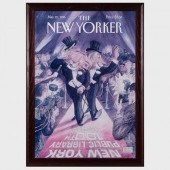 21TH CENTURY SCHOOL: THE NEW
21TH CENTURY SCHOOL: THE NEW YORKERPhotomechanical reproduction; and Attack of the 50ft. Woman , photomechanical reproduction. Both approximately 33 x 23 in. (sight), 38 x 31 in. (frame). Condition Both apparently in good condition. Not examined out of frame.Not withstanding this report or any discussion concerning condition of a lot, all lots are offered and sold "as is" in accordance with our conditions of sale.
21TH CENTURY SCHOOL: THE NEW
21TH CENTURY SCHOOL: THE NEW YORKERPhotomechanical reproduction; and Attack of the 50ft. Woman , photomechanical reproduction. Both approximately 33 x 23 in. (sight), 38 x 31 in. (frame). Condition Both apparently in good condition. Not examined out of frame.Not withstanding this report or any discussion concerning condition of a lot, all lots are offered and sold "as is" in accordance with our conditions of sale. -
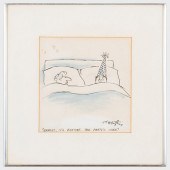 HENRY MARTIN (1925-2020): ERNEST,
HENRY MARTIN (1925-2020): ERNEST, IT'S BEDTIME, THE PARTY'S OVER, FOR THE NEW YORKERInk and watercolor on paper, signed 'H. Martin' lower right, titled at bottom, with The New Yorker copyright label on the reverse, with various notation from the editorial department on a paper mount. 11 x 8 3/4 in. (sheet), 12 3/8 x 12 1/8 in. (frame). Condition Staining. Typed title with white-out below ink title under the mat. Soft creasing.Not withstanding this report or any discussion concerning condition of a lot, all lots are offered and sold "as is" in accordance with our conditions of sale.
HENRY MARTIN (1925-2020): ERNEST,
HENRY MARTIN (1925-2020): ERNEST, IT'S BEDTIME, THE PARTY'S OVER, FOR THE NEW YORKERInk and watercolor on paper, signed 'H. Martin' lower right, titled at bottom, with The New Yorker copyright label on the reverse, with various notation from the editorial department on a paper mount. 11 x 8 3/4 in. (sheet), 12 3/8 x 12 1/8 in. (frame). Condition Staining. Typed title with white-out below ink title under the mat. Soft creasing.Not withstanding this report or any discussion concerning condition of a lot, all lots are offered and sold "as is" in accordance with our conditions of sale. -
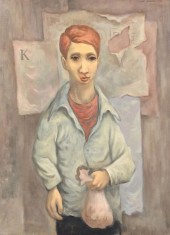 THOMAS B. ALLEN PAINTINGThomas B.
THOMAS B. ALLEN PAINTINGThomas B. Allen (Tennessee/New York, 1928-2004) oil on canvas painting of a boy holding a bag of marbles, standing against a wall plastered with paper signs. Wide stained wood frame. Signed upper right and dated 1950. 29-3/4" x 21-3/4" sight, 37" x 29-1/4" framed. Biography: Nashville-born illustration artist and painter Thomas B. Allen studied at Vanderbilt University and the Art Institute of Chicago. His illustration work appeared in numerous publications including Life, McCalls, and The New Yorker. In 1959 he illustrated a story for Esquire Magazine about bluegrass singers Lester Flatt and Earl Scruggs, which led to a close and longtime collaboration, including seventeen country music album covers. Allen earned a New York Art Directors Club Gold Medal and a Gold Medal from the Society of Illustrators. He taught at the School of Visual Arts in New York and at the Parsons School of Design, Syracuse University, and the Ringling School of Art and Design. A retrospective of his work, organized by the recording artist Marty Stuart, was held from 2000-2002 at the Grand Ole Opry. Condition: Excellent condition.
THOMAS B. ALLEN PAINTINGThomas B.
THOMAS B. ALLEN PAINTINGThomas B. Allen (Tennessee/New York, 1928-2004) oil on canvas painting of a boy holding a bag of marbles, standing against a wall plastered with paper signs. Wide stained wood frame. Signed upper right and dated 1950. 29-3/4" x 21-3/4" sight, 37" x 29-1/4" framed. Biography: Nashville-born illustration artist and painter Thomas B. Allen studied at Vanderbilt University and the Art Institute of Chicago. His illustration work appeared in numerous publications including Life, McCalls, and The New Yorker. In 1959 he illustrated a story for Esquire Magazine about bluegrass singers Lester Flatt and Earl Scruggs, which led to a close and longtime collaboration, including seventeen country music album covers. Allen earned a New York Art Directors Club Gold Medal and a Gold Medal from the Society of Illustrators. He taught at the School of Visual Arts in New York and at the Parsons School of Design, Syracuse University, and the Ringling School of Art and Design. A retrospective of his work, organized by the recording artist Marty Stuart, was held from 2000-2002 at the Grand Ole Opry. Condition: Excellent condition. -
 2 CHATEAU MOUTON ROTHSCHILD/BARON
2 CHATEAU MOUTON ROTHSCHILD/BARON PHILIPPE WINE LABEL L...1st item: 1982 Chateau Mouton Rothschild/Baron Philippe wine label lithograph, designed by John Huston and signed in the plate "In celebration of my beloved friend Baron Philippe's 60th harvest at Mouton, John Houston". Note: Best known as a film director, but also a boxer, art lover, writer, horse trainer, big-game hunter and actor, John Huston (1906-1987) was a talented painter from an early age. This watercolour for the Mouton Rothschild 1982 label is one of the last pictures he ever painted. 2nd item: 1983 Chateau Mouton Rothschild wine label lithograph, originally painted by Saul Steinberg (1914-1999) and initialed ST in the plate. The Romanian-born American painter and cartoonist moved to New York in 1941 and was a regular contributor to The New Yorker. Steinberg later developed the theme of human solitude: empty beaches where the human figure is a dot in the distance, etc., which inspired his design for 1983 label. Both Late 20th century. (Higher-resolution photos are available at www.caseantiques.com) Condition: Both in excellent condition. 21 7/8"H x 16 7/8"W.
2 CHATEAU MOUTON ROTHSCHILD/BARON
2 CHATEAU MOUTON ROTHSCHILD/BARON PHILIPPE WINE LABEL L...1st item: 1982 Chateau Mouton Rothschild/Baron Philippe wine label lithograph, designed by John Huston and signed in the plate "In celebration of my beloved friend Baron Philippe's 60th harvest at Mouton, John Houston". Note: Best known as a film director, but also a boxer, art lover, writer, horse trainer, big-game hunter and actor, John Huston (1906-1987) was a talented painter from an early age. This watercolour for the Mouton Rothschild 1982 label is one of the last pictures he ever painted. 2nd item: 1983 Chateau Mouton Rothschild wine label lithograph, originally painted by Saul Steinberg (1914-1999) and initialed ST in the plate. The Romanian-born American painter and cartoonist moved to New York in 1941 and was a regular contributor to The New Yorker. Steinberg later developed the theme of human solitude: empty beaches where the human figure is a dot in the distance, etc., which inspired his design for 1983 label. Both Late 20th century. (Higher-resolution photos are available at www.caseantiques.com) Condition: Both in excellent condition. 21 7/8"H x 16 7/8"W. -
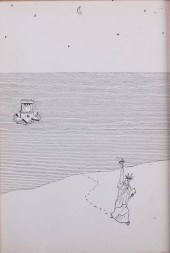 ANDRZEJ CZECZOT INK ON
ANDRZEJ CZECZOT INK ON PAPERArtist and illustrator Andrzej Czeczot (Poland, 1933 – 2012) ink on paper depicting an animated version of the Statue of Liberty walking on the shore and part of a series of six (see others in catalog); signed verso "Copyright by Andrzej Czeczot" with a frame cut-out to display signature; measures approximately 14-3/4" x 11-1/2" with frame and has a sight image of approximately 10-5/8" x 7-1/4"; in good overall condition. Born in Kraków on the 27th of October 1933, Andrzej Czeczot was best known for his illustrations and works of graphic design for prestigious Polish publications Polityka, Polska, Ty i Ja, Literatura and more. He graduated from the Kraków Academy of Fine Arts and debuted in 1956 as a caricaturist for the Szpilka weekly and expanded his work to include film animations. In 1972 he received the Special Prize at the 2nd Biennale Festival of the Applied Graphics in Brno for his illustrations for book The Good Soldier Schweick and received the Golden Pin (Zlota szpilka) for excellence in illustration three times. He was interned on the 13th of December 1981 as part of the government's roundups of intellectuals and artists upon the enforcement of Martial Law. He left Poland not long after his release in 1982 and continued his work in the United States, first working for the Polish newspaper Nowy Dziennik and later for the New York Times, Wall Street Journal and The New Yorker. He returned to Poland in the 1990s and contributed to the Polityka and Nie weeklies. In 2002 he produced a feature-length animated film titled Eden, an ironic fairy tale about the state of contemporary culture, which won him a special jury award at the 27th International Film Festival in Gdynia. Over his lifetime he made over 30 short animated films, illustrated some 200 books and designed over 450 book covers. He died in Warsaw on May 9th, 2012 at the age of 79.
ANDRZEJ CZECZOT INK ON
ANDRZEJ CZECZOT INK ON PAPERArtist and illustrator Andrzej Czeczot (Poland, 1933 – 2012) ink on paper depicting an animated version of the Statue of Liberty walking on the shore and part of a series of six (see others in catalog); signed verso "Copyright by Andrzej Czeczot" with a frame cut-out to display signature; measures approximately 14-3/4" x 11-1/2" with frame and has a sight image of approximately 10-5/8" x 7-1/4"; in good overall condition. Born in Kraków on the 27th of October 1933, Andrzej Czeczot was best known for his illustrations and works of graphic design for prestigious Polish publications Polityka, Polska, Ty i Ja, Literatura and more. He graduated from the Kraków Academy of Fine Arts and debuted in 1956 as a caricaturist for the Szpilka weekly and expanded his work to include film animations. In 1972 he received the Special Prize at the 2nd Biennale Festival of the Applied Graphics in Brno for his illustrations for book The Good Soldier Schweick and received the Golden Pin (Zlota szpilka) for excellence in illustration three times. He was interned on the 13th of December 1981 as part of the government's roundups of intellectuals and artists upon the enforcement of Martial Law. He left Poland not long after his release in 1982 and continued his work in the United States, first working for the Polish newspaper Nowy Dziennik and later for the New York Times, Wall Street Journal and The New Yorker. He returned to Poland in the 1990s and contributed to the Polityka and Nie weeklies. In 2002 he produced a feature-length animated film titled Eden, an ironic fairy tale about the state of contemporary culture, which won him a special jury award at the 27th International Film Festival in Gdynia. Over his lifetime he made over 30 short animated films, illustrated some 200 books and designed over 450 book covers. He died in Warsaw on May 9th, 2012 at the age of 79. -
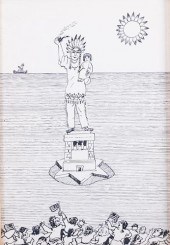 ANDRZEJ CZECZOT INK ON
ANDRZEJ CZECZOT INK ON PAPERArtist and illustrator Andrzej Czeczot (Poland, 1933 – 2012) ink on paper depicting a Native American version of the Statue of Liberty and part of a series of six (see others in catalog); signed verso "Copyright by Andrzej Czeczot" with a frame cut-out to display signature; measures approximately 14-3/4" x 11-1/2" with frame and has a sight image of approximately 10-5/8" x 7-1/4"; in good overall condition. Born in Kraków on the 27th of October 1933, Andrzej Czeczot was best known for his illustrations and works of graphic design for prestigious Polish publications Polityka, Polska, Ty i Ja, Literatura and more. He graduated from the Kraków Academy of Fine Arts and debuted in 1956 as a caricaturist for the Szpilka weekly and expanded his work to include film animations. In 1972 he received the Special Prize at the 2nd Biennale Festival of the Applied Graphics in Brno for his illustrations for book The Good Soldier Schweick and received the Golden Pin (Zlota szpilka) for excellence in illustration three times. He was interned on the 13th of December 1981 as part of the government's roundups of intellectuals and artists upon the enforcement of Martial Law. He left Poland not long after his release in 1982 and continued his work in the United States, first working for the Polish newspaper Nowy Dziennik and later for the New York Times, Wall Street Journal and The New Yorker. He returned to Poland in the 1990s and contributed to the Polityka and Nie weeklies. In 2002 he produced a feature-length animated film titled Eden, an ironic fairy tale about the state of contemporary culture, which won him a special jury award at the 27th International Film Festival in Gdynia. Over his lifetime he made over 30 short animated films, illustrated some 200 books and designed over 450 book covers. He died in Warsaw on May 9th, 2012 at the age of 79.
ANDRZEJ CZECZOT INK ON
ANDRZEJ CZECZOT INK ON PAPERArtist and illustrator Andrzej Czeczot (Poland, 1933 – 2012) ink on paper depicting a Native American version of the Statue of Liberty and part of a series of six (see others in catalog); signed verso "Copyright by Andrzej Czeczot" with a frame cut-out to display signature; measures approximately 14-3/4" x 11-1/2" with frame and has a sight image of approximately 10-5/8" x 7-1/4"; in good overall condition. Born in Kraków on the 27th of October 1933, Andrzej Czeczot was best known for his illustrations and works of graphic design for prestigious Polish publications Polityka, Polska, Ty i Ja, Literatura and more. He graduated from the Kraków Academy of Fine Arts and debuted in 1956 as a caricaturist for the Szpilka weekly and expanded his work to include film animations. In 1972 he received the Special Prize at the 2nd Biennale Festival of the Applied Graphics in Brno for his illustrations for book The Good Soldier Schweick and received the Golden Pin (Zlota szpilka) for excellence in illustration three times. He was interned on the 13th of December 1981 as part of the government's roundups of intellectuals and artists upon the enforcement of Martial Law. He left Poland not long after his release in 1982 and continued his work in the United States, first working for the Polish newspaper Nowy Dziennik and later for the New York Times, Wall Street Journal and The New Yorker. He returned to Poland in the 1990s and contributed to the Polityka and Nie weeklies. In 2002 he produced a feature-length animated film titled Eden, an ironic fairy tale about the state of contemporary culture, which won him a special jury award at the 27th International Film Festival in Gdynia. Over his lifetime he made over 30 short animated films, illustrated some 200 books and designed over 450 book covers. He died in Warsaw on May 9th, 2012 at the age of 79. -
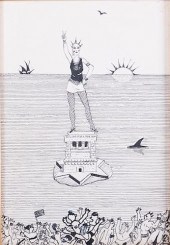 ANDRZEJ CZECZOT INK ON
ANDRZEJ CZECZOT INK ON PAPERArtist and illustrator Andrzej Czeczot (Poland, 1933 – 2012) ink on paper depicting a "punk" version of the Statue of Liberty and part of a series of six (see others in catalog); signed verso "Copyright by Andrzej Czeczot" with a frame cut-out to display signature; measures approximately 14-3/4" x 11-1/2" with frame and has a sight image of approximately 10-5/8" x 7-1/4"; in good overall condition. Born in Kraków on the 27th of October 1933, Andrzej Czeczot was best known for his illustrations and works of graphic design for prestigious Polish publications Polityka, Polska, Ty i Ja, Literatura and more. He graduated from the Kraków Academy of Fine Arts and debuted in 1956 as a caricaturist for the Szpilka weekly and expanded his work to include film animations. In 1972 he received the Special Prize at the 2nd Biennale Festival of the Applied Graphics in Brno for his illustrations for book The Good Soldier Schweick and received the Golden Pin (Zlota szpilka) for excellence in illustration three times. He was interned on the 13th of December 1981 as part of the government's roundups of intellectuals and artists upon the enforcement of Martial Law. He left Poland not long after his release in 1982 and continued his work in the United States, first working for the Polish newspaper Nowy Dziennik and later for the New York Times, Wall Street Journal and The New Yorker. He returned to Poland in the 1990s and contributed to the Polityka and Nie weeklies. In 2002 he produced a feature-length animated film titled Eden, an ironic fairy tale about the state of contemporary culture, which won him a special jury award at the 27th International Film Festival in Gdynia. Over his lifetime he made over 30 short animated films, illustrated some 200 books and designed over 450 book covers. He died in Warsaw on May 9th, 2012 at the age of 79.
ANDRZEJ CZECZOT INK ON
ANDRZEJ CZECZOT INK ON PAPERArtist and illustrator Andrzej Czeczot (Poland, 1933 – 2012) ink on paper depicting a "punk" version of the Statue of Liberty and part of a series of six (see others in catalog); signed verso "Copyright by Andrzej Czeczot" with a frame cut-out to display signature; measures approximately 14-3/4" x 11-1/2" with frame and has a sight image of approximately 10-5/8" x 7-1/4"; in good overall condition. Born in Kraków on the 27th of October 1933, Andrzej Czeczot was best known for his illustrations and works of graphic design for prestigious Polish publications Polityka, Polska, Ty i Ja, Literatura and more. He graduated from the Kraków Academy of Fine Arts and debuted in 1956 as a caricaturist for the Szpilka weekly and expanded his work to include film animations. In 1972 he received the Special Prize at the 2nd Biennale Festival of the Applied Graphics in Brno for his illustrations for book The Good Soldier Schweick and received the Golden Pin (Zlota szpilka) for excellence in illustration three times. He was interned on the 13th of December 1981 as part of the government's roundups of intellectuals and artists upon the enforcement of Martial Law. He left Poland not long after his release in 1982 and continued his work in the United States, first working for the Polish newspaper Nowy Dziennik and later for the New York Times, Wall Street Journal and The New Yorker. He returned to Poland in the 1990s and contributed to the Polityka and Nie weeklies. In 2002 he produced a feature-length animated film titled Eden, an ironic fairy tale about the state of contemporary culture, which won him a special jury award at the 27th International Film Festival in Gdynia. Over his lifetime he made over 30 short animated films, illustrated some 200 books and designed over 450 book covers. He died in Warsaw on May 9th, 2012 at the age of 79. -
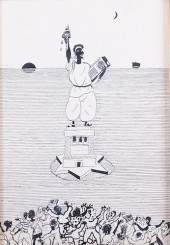 ANDRZEJ CZECZOT INK ON
ANDRZEJ CZECZOT INK ON PAPERArtist and illustrator Andrzej Czeczot (Poland, 1933 – 2012) ink on paper depicting an African American version of the Statue of Liberty and part of a series of six (see others in catalog); signed verso "Copyright by Andrzej Czeczot" with a frame cut-out to display signature; measures approximately 14-3/4" x 11-1/2" with frame and has a sight image of approximately 10-5/8" x 7-1/4"; in good overall condition. Born in Kraków on the 27th of October 1933, Andrzej Czeczot was best known for his illustrations and works of graphic design for prestigious Polish publications Polityka, Polska, Ty i Ja, Literatura and more. He graduated from the Kraków Academy of Fine Arts and debuted in 1956 as a caricaturist for the Szpilka weekly and expanded his work to include film animations. In 1972 he received the Special Prize at the 2nd Biennale Festival of the Applied Graphics in Brno for his illustrations for book The Good Soldier Schweick and received the Golden Pin (Zlota szpilka) for excellence in illustration three times. He was interned on the 13th of December 1981 as part of the government's roundups of intellectuals and artists upon the enforcement of Martial Law. He left Poland not long after his release in 1982 and continued his work in the United States, first working for the Polish newspaper Nowy Dziennik and later for the New York Times, Wall Street Journal and The New Yorker. He returned to Poland in the 1990s and contributed to the Polityka and Nie weeklies. In 2002 he produced a feature-length animated film titled Eden, an ironic fairy tale about the state of contemporary culture, which won him a special jury award at the 27th International Film Festival in Gdynia. Over his lifetime he made over 30 short animated films, illustrated some 200 books and designed over 450 book covers. He died in Warsaw on May 9th, 2012 at the age of 79.
ANDRZEJ CZECZOT INK ON
ANDRZEJ CZECZOT INK ON PAPERArtist and illustrator Andrzej Czeczot (Poland, 1933 – 2012) ink on paper depicting an African American version of the Statue of Liberty and part of a series of six (see others in catalog); signed verso "Copyright by Andrzej Czeczot" with a frame cut-out to display signature; measures approximately 14-3/4" x 11-1/2" with frame and has a sight image of approximately 10-5/8" x 7-1/4"; in good overall condition. Born in Kraków on the 27th of October 1933, Andrzej Czeczot was best known for his illustrations and works of graphic design for prestigious Polish publications Polityka, Polska, Ty i Ja, Literatura and more. He graduated from the Kraków Academy of Fine Arts and debuted in 1956 as a caricaturist for the Szpilka weekly and expanded his work to include film animations. In 1972 he received the Special Prize at the 2nd Biennale Festival of the Applied Graphics in Brno for his illustrations for book The Good Soldier Schweick and received the Golden Pin (Zlota szpilka) for excellence in illustration three times. He was interned on the 13th of December 1981 as part of the government's roundups of intellectuals and artists upon the enforcement of Martial Law. He left Poland not long after his release in 1982 and continued his work in the United States, first working for the Polish newspaper Nowy Dziennik and later for the New York Times, Wall Street Journal and The New Yorker. He returned to Poland in the 1990s and contributed to the Polityka and Nie weeklies. In 2002 he produced a feature-length animated film titled Eden, an ironic fairy tale about the state of contemporary culture, which won him a special jury award at the 27th International Film Festival in Gdynia. Over his lifetime he made over 30 short animated films, illustrated some 200 books and designed over 450 book covers. He died in Warsaw on May 9th, 2012 at the age of 79. -
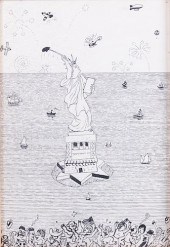 ANDRZEJ CZECZOT INK ON
ANDRZEJ CZECZOT INK ON PAPERArtist and illustrator Andrzej Czeczot (Poland, 1933 – 2012) ink on paper depicting an animated version of the Statue of Liberty and part of a series of six (see others in catalog); signed verso "Copyright by Andrzej Czeczot" with a frame cut-out to display signature; measures approximately 14-3/4" x 11-1/2" with frame and has a sight image of approximately 10-5/8" x 7-1/4"; in good overall condition with some staining to glass. Born in Kraków on the 27th of October 1933, Andrzej Czeczot was best known for his illustrations and works of graphic design for prestigious Polish publications Polityka, Polska, Ty i Ja, Literatura and more. He graduated from the Kraków Academy of Fine Arts and debuted in 1956 as a caricaturist for the Szpilka weekly and expanded his work to include film animations. In 1972 he received the Special Prize at the 2nd Biennale Festival of the Applied Graphics in Brno for his illustrations for book The Good Soldier Schweick and received the Golden Pin (Zlota szpilka) for excellence in illustration three times. He was interned on the 13th of December 1981 as part of the government's roundups of intellectuals and artists upon the enforcement of Martial Law. He left Poland not long after his release in 1982 and continued his work in the United States, first working for the Polish newspaper Nowy Dziennik and later for the New York Times, Wall Street Journal and The New Yorker. He returned to Poland in the 1990s and contributed to the Polityka and Nie weeklies. In 2002 he produced a feature-length animated film titled Eden, an ironic fairy tale about the state of contemporary culture, which won him a special jury award at the 27th International Film Festival in Gdynia. Over his lifetime he made over 30 short animated films, illustrated some 200 books and designed over 450 book covers. He died in Warsaw on May 9th, 2012 at the age of 79.
ANDRZEJ CZECZOT INK ON
ANDRZEJ CZECZOT INK ON PAPERArtist and illustrator Andrzej Czeczot (Poland, 1933 – 2012) ink on paper depicting an animated version of the Statue of Liberty and part of a series of six (see others in catalog); signed verso "Copyright by Andrzej Czeczot" with a frame cut-out to display signature; measures approximately 14-3/4" x 11-1/2" with frame and has a sight image of approximately 10-5/8" x 7-1/4"; in good overall condition with some staining to glass. Born in Kraków on the 27th of October 1933, Andrzej Czeczot was best known for his illustrations and works of graphic design for prestigious Polish publications Polityka, Polska, Ty i Ja, Literatura and more. He graduated from the Kraków Academy of Fine Arts and debuted in 1956 as a caricaturist for the Szpilka weekly and expanded his work to include film animations. In 1972 he received the Special Prize at the 2nd Biennale Festival of the Applied Graphics in Brno for his illustrations for book The Good Soldier Schweick and received the Golden Pin (Zlota szpilka) for excellence in illustration three times. He was interned on the 13th of December 1981 as part of the government's roundups of intellectuals and artists upon the enforcement of Martial Law. He left Poland not long after his release in 1982 and continued his work in the United States, first working for the Polish newspaper Nowy Dziennik and later for the New York Times, Wall Street Journal and The New Yorker. He returned to Poland in the 1990s and contributed to the Polityka and Nie weeklies. In 2002 he produced a feature-length animated film titled Eden, an ironic fairy tale about the state of contemporary culture, which won him a special jury award at the 27th International Film Festival in Gdynia. Over his lifetime he made over 30 short animated films, illustrated some 200 books and designed over 450 book covers. He died in Warsaw on May 9th, 2012 at the age of 79. -
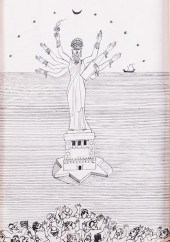 ANDRZEJ CZECZOT INK ON
ANDRZEJ CZECZOT INK ON PAPERArtist and illustrator Andrzej Czeczot (Poland, 1933 – 2012) ink on paper depicting a Hindu version of the Statue of Liberty and part of a series of six (see others in catalog); signed verso "Copyright by Andrzej Czeczot" with a frame cut-out to display signature; measures approximately 14-3/4" x 11-1/2" with frame and has a sight image of approximately 10-5/8" x 7-1/4"; in fair overall condition with some staining to paper; frame missing glass. Born in Kraków on the 27th of October 1933, Andrzej Czeczot was best known for his illustrations and works of graphic design for prestigious Polish publications Polityka, Polska, Ty i Ja, Literatura and more. He graduated from the Kraków Academy of Fine Arts and debuted in 1956 as a caricaturist for the Szpilka weekly and expanded his work to include film animations. In 1972 he received the Special Prize at the 2nd Biennale Festival of the Applied Graphics in Brno for his illustrations for book The Good Soldier Schweick and received the Golden Pin (Zlota szpilka) for excellence in illustration three times. He was interned on the 13th of December 1981 as part of the government's roundups of intellectuals and artists upon the enforcement of Martial Law. He left Poland not long after his release in 1982 and continued his work in the United States, first working for the Polish newspaper Nowy Dziennik and later for the New York Times, Wall Street Journal and The New Yorker. He returned to Poland in the 1990s and contributed to the Polityka and Nie weeklies. In 2002 he produced a feature-length animated film titled Eden, an ironic fairy tale about the state of contemporary culture, which won him a special jury award at the 27th International Film Festival in Gdynia. Over his lifetime he made over 30 short animated films, illustrated some 200 books and designed over 450 book covers. He died in Warsaw on May 9th, 2012 at the age of 79.
ANDRZEJ CZECZOT INK ON
ANDRZEJ CZECZOT INK ON PAPERArtist and illustrator Andrzej Czeczot (Poland, 1933 – 2012) ink on paper depicting a Hindu version of the Statue of Liberty and part of a series of six (see others in catalog); signed verso "Copyright by Andrzej Czeczot" with a frame cut-out to display signature; measures approximately 14-3/4" x 11-1/2" with frame and has a sight image of approximately 10-5/8" x 7-1/4"; in fair overall condition with some staining to paper; frame missing glass. Born in Kraków on the 27th of October 1933, Andrzej Czeczot was best known for his illustrations and works of graphic design for prestigious Polish publications Polityka, Polska, Ty i Ja, Literatura and more. He graduated from the Kraków Academy of Fine Arts and debuted in 1956 as a caricaturist for the Szpilka weekly and expanded his work to include film animations. In 1972 he received the Special Prize at the 2nd Biennale Festival of the Applied Graphics in Brno for his illustrations for book The Good Soldier Schweick and received the Golden Pin (Zlota szpilka) for excellence in illustration three times. He was interned on the 13th of December 1981 as part of the government's roundups of intellectuals and artists upon the enforcement of Martial Law. He left Poland not long after his release in 1982 and continued his work in the United States, first working for the Polish newspaper Nowy Dziennik and later for the New York Times, Wall Street Journal and The New Yorker. He returned to Poland in the 1990s and contributed to the Polityka and Nie weeklies. In 2002 he produced a feature-length animated film titled Eden, an ironic fairy tale about the state of contemporary culture, which won him a special jury award at the 27th International Film Festival in Gdynia. Over his lifetime he made over 30 short animated films, illustrated some 200 books and designed over 450 book covers. He died in Warsaw on May 9th, 2012 at the age of 79. -
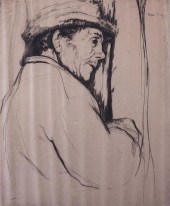 WILLIAM AUERBACH-LEVY "CABBY"
WILLIAM AUERBACH-LEVY "CABBY" ETCHINGWilliam Auerbach-Levy (Russian, 1889–1964) framed under glass "Cabby" etching; signed in plate and pencil signed below image; measures approximately 19" in height by16-5/8" in width with frame and has a sight image of approximately 13-1/4" in height by 10-13/16" in width. William Auerbach-Levy (Russian, 1889–1964) was born in Brest-Litovsk, Russia and came to America at the age of five with his parents. His artistic training was in New York and Paris, he was famous as a caricaturist, for The New Yorker and Vanity Fair among others.
WILLIAM AUERBACH-LEVY "CABBY"
WILLIAM AUERBACH-LEVY "CABBY" ETCHINGWilliam Auerbach-Levy (Russian, 1889–1964) framed under glass "Cabby" etching; signed in plate and pencil signed below image; measures approximately 19" in height by16-5/8" in width with frame and has a sight image of approximately 13-1/4" in height by 10-13/16" in width. William Auerbach-Levy (Russian, 1889–1964) was born in Brest-Litovsk, Russia and came to America at the age of five with his parents. His artistic training was in New York and Paris, he was famous as a caricaturist, for The New Yorker and Vanity Fair among others. -
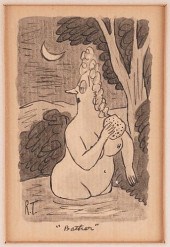 RICHARD TAYLOR "BATHER" PEN &
RICHARD TAYLOR "BATHER" PEN & INKRichard Denison Taylor (Canadian/American, 1902-1970). Small pen and ink drawing titled "Bather," depicting a female nude bathing herself in moonlit waters. Initialed along the lower left. Titled along the lower center. Taylor is known for his newspaper comic strips and book illustrations, most notably those he created for the New Yorker. Height: 5 1/2 in x width: 3 3/4 in. Condition: Please contact us for a detailed condition report. Please note that the lack of a condition statement does not imply perfect condition. Email condition@revereauctions.com with any condition questions.
RICHARD TAYLOR "BATHER" PEN &
RICHARD TAYLOR "BATHER" PEN & INKRichard Denison Taylor (Canadian/American, 1902-1970). Small pen and ink drawing titled "Bather," depicting a female nude bathing herself in moonlit waters. Initialed along the lower left. Titled along the lower center. Taylor is known for his newspaper comic strips and book illustrations, most notably those he created for the New Yorker. Height: 5 1/2 in x width: 3 3/4 in. Condition: Please contact us for a detailed condition report. Please note that the lack of a condition statement does not imply perfect condition. Email condition@revereauctions.com with any condition questions. -
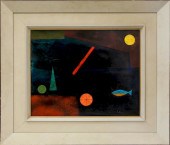 CHARLES GREEN SHAW OIL ON PANEL
CHARLES GREEN SHAW OIL ON PANEL "YELLOW SUN"CHARLES GREEN SHAW (1892-1974) OIL ON PANEL "YELLOW SUN" , signed lower right Shaw with Bertha Schafer label on verso. 16 in. x 20 in. Overall 25 ½ in. x 29 ½ in. Charles Green Shaw was born in 1892 in New York City. He studied at Yale University, at the Columbia University School of Architecture, and at the Art Students League of New York. He then studied under the Ashcan School painter George Luks and under the Regionalist Thomas Hart Benton. An heir to the Woolworth empire, Shaw was known as a socialite and a man about town, and in the twenties, he chronicled the café society that he frequented in the social pages of The New Yorker, The Smart Set and Vanity Fair. Shaw became serious about painting when he took a trip to Paris in 1929 to see Albert E. Gallatin and George L.K. Morris and spent the next four years perfecting a style that would incorporate cubist, fauve and de Stijl elements. In the 1940s Shaw began painting monochromatic planes of intersecting color. Although he used familiar shapes, such as rectangles, triangles, circles and grids in Yellow Sun the shapes take on a more representative function. The yellow orb in the top right corner of the painting suggests the sun, and the two-toned shape below it looks like a fish. Although the forms are, again, geometric shapes in primary colors, the composition suggests something of a landscape. Although the painting as a whole is abstract, the symbols are not. As Shaw laid out a three-dimensional plane of bright, geometric shapes he peppered it with familiar objects that begin to tell a story. In this article “A Word to the Objector,” Shaw displays his profound commitment to his belief that abstract painting was “an appeal to one’s …aesthetic emotion along… (rather than) to those vastly more familiar emotions which are a mixture of sentimentality, prettiness, anecdote, and melodrama.” Shaw exhibited his work at the San Francisco Museum of Modern Art, Seattle Art Museum, Whitney Museum of American Art, Institute of Contemporary Art, Boston and at the Corcoran Gallery Biennial. His works can be seen in the collections of the Phillips Collection, Washington, D.C., Brooklyn Museum of Art, Whitney Museum of American Art, The Metropolitan Museum of Art, The Museum of Modern Art and the San Francisco Museum of Modern Art. 1 John R. Lane and Susan C. Larsen, Abstract Painting and Sculpture in American (New York: Abrams, 1983), 26. Condition: Items may have wear and tear, imperfections or the effects of aging. Please contact the gallery for further details prior to bidding. Any condition statement given as a courtesy should not be treated as fact.
CHARLES GREEN SHAW OIL ON PANEL
CHARLES GREEN SHAW OIL ON PANEL "YELLOW SUN"CHARLES GREEN SHAW (1892-1974) OIL ON PANEL "YELLOW SUN" , signed lower right Shaw with Bertha Schafer label on verso. 16 in. x 20 in. Overall 25 ½ in. x 29 ½ in. Charles Green Shaw was born in 1892 in New York City. He studied at Yale University, at the Columbia University School of Architecture, and at the Art Students League of New York. He then studied under the Ashcan School painter George Luks and under the Regionalist Thomas Hart Benton. An heir to the Woolworth empire, Shaw was known as a socialite and a man about town, and in the twenties, he chronicled the café society that he frequented in the social pages of The New Yorker, The Smart Set and Vanity Fair. Shaw became serious about painting when he took a trip to Paris in 1929 to see Albert E. Gallatin and George L.K. Morris and spent the next four years perfecting a style that would incorporate cubist, fauve and de Stijl elements. In the 1940s Shaw began painting monochromatic planes of intersecting color. Although he used familiar shapes, such as rectangles, triangles, circles and grids in Yellow Sun the shapes take on a more representative function. The yellow orb in the top right corner of the painting suggests the sun, and the two-toned shape below it looks like a fish. Although the forms are, again, geometric shapes in primary colors, the composition suggests something of a landscape. Although the painting as a whole is abstract, the symbols are not. As Shaw laid out a three-dimensional plane of bright, geometric shapes he peppered it with familiar objects that begin to tell a story. In this article “A Word to the Objector,” Shaw displays his profound commitment to his belief that abstract painting was “an appeal to one’s …aesthetic emotion along… (rather than) to those vastly more familiar emotions which are a mixture of sentimentality, prettiness, anecdote, and melodrama.” Shaw exhibited his work at the San Francisco Museum of Modern Art, Seattle Art Museum, Whitney Museum of American Art, Institute of Contemporary Art, Boston and at the Corcoran Gallery Biennial. His works can be seen in the collections of the Phillips Collection, Washington, D.C., Brooklyn Museum of Art, Whitney Museum of American Art, The Metropolitan Museum of Art, The Museum of Modern Art and the San Francisco Museum of Modern Art. 1 John R. Lane and Susan C. Larsen, Abstract Painting and Sculpture in American (New York: Abrams, 1983), 26. Condition: Items may have wear and tear, imperfections or the effects of aging. Please contact the gallery for further details prior to bidding. Any condition statement given as a courtesy should not be treated as fact. -
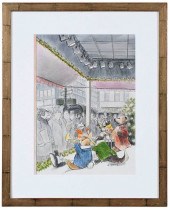 CHARLES DAVID SAXON(New
CHARLES DAVID SAXON(New York/Connecticut, 1920-1988) Stuffed Animal Band, The New Yorker Magazine cover, from December 7, 1981, crayon on paper, sight, 14-1/2 x 10-1/2 in.; gilt wood frame, 21 x 17 in. Provenance: Property Deaccessioned by the Colonial Williamsburg Foundation from the Joseph and June Hennage Collection; all proceeds to benefit the Joseph and June Hennage Collection Acquisition Fund Condition: not examined out of frame, appears in good condition; frame with abrasions
CHARLES DAVID SAXON(New
CHARLES DAVID SAXON(New York/Connecticut, 1920-1988) Stuffed Animal Band, The New Yorker Magazine cover, from December 7, 1981, crayon on paper, sight, 14-1/2 x 10-1/2 in.; gilt wood frame, 21 x 17 in. Provenance: Property Deaccessioned by the Colonial Williamsburg Foundation from the Joseph and June Hennage Collection; all proceeds to benefit the Joseph and June Hennage Collection Acquisition Fund Condition: not examined out of frame, appears in good condition; frame with abrasions -
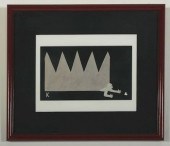 JEFF KAUFMAN FIGURE CHASING HEART
JEFF KAUFMAN FIGURE CHASING HEART COLLAGEThe artist a documentary film maker as well as a cartoonist for The New Yorker and illustrator for The Los Angeles Times and The New York Times. Signed with a K and signed and dated 1990 verso with an inscription from "Jack" to Roth and Claire Bloom. sign size 5.5" x 9.5", framed 14x16 Property from the estate of Philip Roth. Philip Roth was born in Newark New Jersey on 19 March, 1933. The second child of second-generation Americans Bess and Herman Roth, Roth grew up in the largely Jewish community of Weequahic, a neighborhood that he was to return to time and again in his writing. After graduating from Weequahic High School in 1950, he attended Bucknell University, Pennsylvania and the University of Chicago where he received a scholarship to complete his M.A. in English Literature. In 1959, Roth published Goodbye Columbus - a collection of stories and a novella for which he received the National Book Award. Ten years later, the publication of his fourth novel Portnoy's Complaint brought Roth both critical and commercial success, firmly securing his reputation as one of America's finest young writers. Roth was the author of thirty-one books including those that were to follow the fortunes of Nathan Zuckerman and a fictional narrator narrator named Philip Roth through which he explored and gave voice to the complexities of the American experience in the twentieth and twenty-first centuries. Roth's lasting contribution to literature was widely recognized in his lifetime, both in the United States and abroad. Among other commendations he was the recipient of the Pulitzer Prize, the International Man Booker Prize, twice the winner of the National Book Critics Circle Award and the National Book Award and presented with the National Medal of Arts and the National Humanities Medal by Presidents Clinton and Obama respectively. Philip Roth died on 22 May 2018 at the age of eighty-five having retired from writing six years previous. (PROTH816)(TC)
JEFF KAUFMAN FIGURE CHASING HEART
JEFF KAUFMAN FIGURE CHASING HEART COLLAGEThe artist a documentary film maker as well as a cartoonist for The New Yorker and illustrator for The Los Angeles Times and The New York Times. Signed with a K and signed and dated 1990 verso with an inscription from "Jack" to Roth and Claire Bloom. sign size 5.5" x 9.5", framed 14x16 Property from the estate of Philip Roth. Philip Roth was born in Newark New Jersey on 19 March, 1933. The second child of second-generation Americans Bess and Herman Roth, Roth grew up in the largely Jewish community of Weequahic, a neighborhood that he was to return to time and again in his writing. After graduating from Weequahic High School in 1950, he attended Bucknell University, Pennsylvania and the University of Chicago where he received a scholarship to complete his M.A. in English Literature. In 1959, Roth published Goodbye Columbus - a collection of stories and a novella for which he received the National Book Award. Ten years later, the publication of his fourth novel Portnoy's Complaint brought Roth both critical and commercial success, firmly securing his reputation as one of America's finest young writers. Roth was the author of thirty-one books including those that were to follow the fortunes of Nathan Zuckerman and a fictional narrator narrator named Philip Roth through which he explored and gave voice to the complexities of the American experience in the twentieth and twenty-first centuries. Roth's lasting contribution to literature was widely recognized in his lifetime, both in the United States and abroad. Among other commendations he was the recipient of the Pulitzer Prize, the International Man Booker Prize, twice the winner of the National Book Critics Circle Award and the National Book Award and presented with the National Medal of Arts and the National Humanities Medal by Presidents Clinton and Obama respectively. Philip Roth died on 22 May 2018 at the age of eighty-five having retired from writing six years previous. (PROTH816)(TC) -
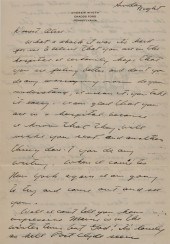 LETTER FROM ANDREW WYETH (AMERICAN,
LETTER FROM ANDREW WYETH (AMERICAN, 1917-2009) TO ALICE MOORELetter from ANDREW WYETH (American, 1917-2009) to Alice Moore, Sunday, March 20, 1938; mailed Monday, March 21, 1938 Dearest Alice: What a shock it was. It's hard for me to believe that you are in the hospital. I certainly hope that you are feeling better and don't you do any worrying now do you understand, I mean it, you take it easy. I am glad that you are in a hospital because I know that they will make you rest, and another thing, don't you do any writing. When I come to New York again I am going to try and come out and see you. Well I can't tell you how impressive Maine is in the winter time but God! It's lovely as hell. Port Clyde seems deserted when you walk down its streets or I should say street. The wind whistling through the buildings makes it all the more stark and you never see a person and when you do it's only for a minute as you see them dart across the street and disappear into a house. But if you want to find the fisherman, just go in a store [sketch of four figures seated around a stove] and you will find them all. In fact, I think they spend most of their time there talking. The weather was beautifully clear while we were in Port Clyde. They have really had a very open winter, very little snow, only six inches, which is strange for Maine. It was pretty cold while we were there. I made several water colors form the car which I may do something with. Some times also made drawings. It's very interesting how different the place looks in the winter, what a deep blue and green the sea is and the rock weed turns very black, which is very effective. I must certainly spend some winters up there and paint some of these things. It never has been touched by an artist that I can recall. Stopped in Boston on the way home and saw the man that runs the art gallery of Doll and Richards. My show is all arranged for there next fall so I guess I will be pretty busy this summer. Also got a book to illustrate from Houghton Mifflin & Co., which I will do before I leave for Maine. Our visit with Kenneth Roberts was a grand one. The place he is living in this winter is a scream. It's in Kennebunkport. The house, or I should say hotel, is owned by a friend of his who let him use it for the winter. It's the most God awful thing I have ever looked at. Roberts himself thinks it terrible. [Sketch of aforementioned building] He took us all over it and made some of the best remarks I have ever heard. I have never laughed as much as I did there. I thought of a very good drawing I'm going to send to the New Yorker of two old ladies standing in front of his house holding a copy of "Northwest Passage" and saying, (So this is Maine) don't you think that would be good. I will tell you more about this visit when I see you. When I arrived home I found a letter from Mr. Macbeth enclosing a letter from the president of the Museum at Atlanta, the Museum that bought one of my water colors, asking me if I would do a painting for his office of some palm trees blowing in the wind, which ought to be swell to do. I finished the sketch for it Saturday and sent it on for his approval. [Sketch of aforementioned painting] I think I am going to do it in Egg Tempera. I want to get a great deal of color in it. I will write again soon and don't forget that I am thinking about you always. I am hoping that you are feeling better so that you will be able to see me when I come up. One thing in your being in the hospital is that you won't be going on any binges. But I really hope that you don't outgrow them altogether, please don't. Good night my sweet dearest, my darling. Andy This letter smells bad to me so hold your nose Condition:
LETTER FROM ANDREW WYETH (AMERICAN,
LETTER FROM ANDREW WYETH (AMERICAN, 1917-2009) TO ALICE MOORELetter from ANDREW WYETH (American, 1917-2009) to Alice Moore, Sunday, March 20, 1938; mailed Monday, March 21, 1938 Dearest Alice: What a shock it was. It's hard for me to believe that you are in the hospital. I certainly hope that you are feeling better and don't you do any worrying now do you understand, I mean it, you take it easy. I am glad that you are in a hospital because I know that they will make you rest, and another thing, don't you do any writing. When I come to New York again I am going to try and come out and see you. Well I can't tell you how impressive Maine is in the winter time but God! It's lovely as hell. Port Clyde seems deserted when you walk down its streets or I should say street. The wind whistling through the buildings makes it all the more stark and you never see a person and when you do it's only for a minute as you see them dart across the street and disappear into a house. But if you want to find the fisherman, just go in a store [sketch of four figures seated around a stove] and you will find them all. In fact, I think they spend most of their time there talking. The weather was beautifully clear while we were in Port Clyde. They have really had a very open winter, very little snow, only six inches, which is strange for Maine. It was pretty cold while we were there. I made several water colors form the car which I may do something with. Some times also made drawings. It's very interesting how different the place looks in the winter, what a deep blue and green the sea is and the rock weed turns very black, which is very effective. I must certainly spend some winters up there and paint some of these things. It never has been touched by an artist that I can recall. Stopped in Boston on the way home and saw the man that runs the art gallery of Doll and Richards. My show is all arranged for there next fall so I guess I will be pretty busy this summer. Also got a book to illustrate from Houghton Mifflin & Co., which I will do before I leave for Maine. Our visit with Kenneth Roberts was a grand one. The place he is living in this winter is a scream. It's in Kennebunkport. The house, or I should say hotel, is owned by a friend of his who let him use it for the winter. It's the most God awful thing I have ever looked at. Roberts himself thinks it terrible. [Sketch of aforementioned building] He took us all over it and made some of the best remarks I have ever heard. I have never laughed as much as I did there. I thought of a very good drawing I'm going to send to the New Yorker of two old ladies standing in front of his house holding a copy of "Northwest Passage" and saying, (So this is Maine) don't you think that would be good. I will tell you more about this visit when I see you. When I arrived home I found a letter from Mr. Macbeth enclosing a letter from the president of the Museum at Atlanta, the Museum that bought one of my water colors, asking me if I would do a painting for his office of some palm trees blowing in the wind, which ought to be swell to do. I finished the sketch for it Saturday and sent it on for his approval. [Sketch of aforementioned painting] I think I am going to do it in Egg Tempera. I want to get a great deal of color in it. I will write again soon and don't forget that I am thinking about you always. I am hoping that you are feeling better so that you will be able to see me when I come up. One thing in your being in the hospital is that you won't be going on any binges. But I really hope that you don't outgrow them altogether, please don't. Good night my sweet dearest, my darling. Andy This letter smells bad to me so hold your nose Condition: -
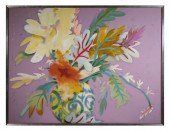 MICHAEL VOLLBRACHT, LARGE OIL ON
MICHAEL VOLLBRACHT, LARGE OIL ON CANVAS, FLOWERSLarge oil on canvas painting by renowned artist and fashion designer Michael Vollbracht (American, 1947-2018). Brightly colored floral still life on lavender background. Overall framed size is 55" x 42". Signed at top left. Excellent condition with some wear to the framing. Vollbracht was head designer for Bill Blass from 2003 to 2007 and has designed and illustrated for Geoffrey Beene, Henri Bendel, Bloomingdales and many others. Named a top illustrator by The New Yorker in 1989. shipping info This item will need to be shipped by a packing company of your choice. We maintain a list of reliable shippers, or you may choose your own.
MICHAEL VOLLBRACHT, LARGE OIL ON
MICHAEL VOLLBRACHT, LARGE OIL ON CANVAS, FLOWERSLarge oil on canvas painting by renowned artist and fashion designer Michael Vollbracht (American, 1947-2018). Brightly colored floral still life on lavender background. Overall framed size is 55" x 42". Signed at top left. Excellent condition with some wear to the framing. Vollbracht was head designer for Bill Blass from 2003 to 2007 and has designed and illustrated for Geoffrey Beene, Henri Bendel, Bloomingdales and many others. Named a top illustrator by The New Yorker in 1989. shipping info This item will need to be shipped by a packing company of your choice. We maintain a list of reliable shippers, or you may choose your own. -
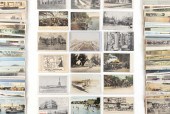 (VIEW) NEW YORK - COVERING "K"
(VIEW) NEW YORK - COVERING "K" THROUGH "O" TOWNS: 134 POSTCARDS EARLY TO MID-20TH CENTURY(VIEW) NEW YORK - COVERING "K" THROUGH "O" TOWNS: 134 POSTCARDS, Early to Mid-20th Century, Real photo "National Boulevard Long Beach...1912" with early autos, "Old Orchard" interior (Rt. 20), Long Branch tornado card (1912), Cutting Room of Endicott, Johnson & Co., Tung Hoy Restaurant in Larchmont, Rotograph of Canada St. Lake George, Summit Farm Tea Room, Montauk Manor, Mountain Lake view, Blossom Farm Lodge with Tydol advertising, Tabernacle at Camp Ground (Mooers). NYC (54Radio City interior, cards): skyline views, Maggi Co. plant, Rotograph of "Crosstown Rapid Transit 1905", restaurant interiors, "Coloring The Meerschaum Pipe" (Cavanagh's), two early fire engine cards, children's surgical ward, "The New Yorker" sightseeing yacht, etc. Three Bobby Leach Niagara Falls cards, skiing at North Creek, Shoremont Restaurant with Shell adv., "Devil's Bedroom Carmine's Glen, "Shooting an Oil Well" (Olean), real photo dredge, bathing scene at Olcott Beach, tank fire (Olean) and more.
(VIEW) NEW YORK - COVERING "K"
(VIEW) NEW YORK - COVERING "K" THROUGH "O" TOWNS: 134 POSTCARDS EARLY TO MID-20TH CENTURY(VIEW) NEW YORK - COVERING "K" THROUGH "O" TOWNS: 134 POSTCARDS, Early to Mid-20th Century, Real photo "National Boulevard Long Beach...1912" with early autos, "Old Orchard" interior (Rt. 20), Long Branch tornado card (1912), Cutting Room of Endicott, Johnson & Co., Tung Hoy Restaurant in Larchmont, Rotograph of Canada St. Lake George, Summit Farm Tea Room, Montauk Manor, Mountain Lake view, Blossom Farm Lodge with Tydol advertising, Tabernacle at Camp Ground (Mooers). NYC (54Radio City interior, cards): skyline views, Maggi Co. plant, Rotograph of "Crosstown Rapid Transit 1905", restaurant interiors, "Coloring The Meerschaum Pipe" (Cavanagh's), two early fire engine cards, children's surgical ward, "The New Yorker" sightseeing yacht, etc. Three Bobby Leach Niagara Falls cards, skiing at North Creek, Shoremont Restaurant with Shell adv., "Devil's Bedroom Carmine's Glen, "Shooting an Oil Well" (Olean), real photo dredge, bathing scene at Olcott Beach, tank fire (Olean) and more. -
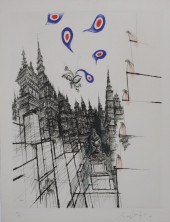 RONALD WILLIAM FORDHAM SEARLE,
RONALD WILLIAM FORDHAM SEARLE, NEW YORK / ENGLAND, FRANCE (1920-2011), I CARE II, 1970, LITHOGRAPHRonald William Fordham Searle, New York / England, France, (1920-2011) I Care II, 1970, lithograph Titled and numbered 58/99 lower left. Signed and dated lower right. Biography from the Archives of askART: Ronald William Fordham Searle, CBE, RDI, (born 3 March 1920, Cambridge, England) is an influential English artist and cartoonist. Best known as the creator of St Trinian's School (the subject of several books and seven full-length films). He is also the co-author (with Geoffrey Willans) of the Molesworth tetralogy. Searle was born in Cambridge where his father was a porter at Cambridge Railway Station. He started drawing at the age of five and left school at the age of 15. In April 1939, realizing that war was inevitable, he abandoned his art studies to enlist in the Royal Engineers. He trained at Cambridge College of Arts and Technology, currently Anglia Ruskin University, for two years, and in 1941, published the first St Trinian's cartoon in the magazine Lilliput. In January 1942 he was stationed in Singapore. After a month of fighting in Malaya, Singapore fell to the Japanese, and he was taken prisoner along with his cousin Tom Fordham Searle. He spent the rest of the war a prisoner, first in Changi Prison and then in the Kwai jungle, working on the Siam-Burma Death Railway. The brutal camp conditions were documented by Searle in a series of drawings that he hid under the mattresses of prisoners dying of cholera. Liberated late in 1945, Searle returned to England where he published several of the surviving drawings in fellow prisoner Russell Braddon's The Naked Island. Most of these drawings appear in his 1986 book, Ronald Searle: To the Kwai and Back, War Drawings 1939-1945. At least one of the drawings is on display at the Changi Museum and Chapel, Singapore, but the majority of these original drawings, approximately 300, are in the permanent collection of the Imperial War Museum, London, along with the works of other POW artists. The best known of these are Jack Bridger Chalker, Philip Meninsky and Ashley George Old. He married the journalist Kaye Webb in 1947; they had twins, Kate and Johnny. Searle produced an extraordinary volume of work during the 1950s, including drawings for Life, Holiday and Punch. His cartoons appeared in The New Yorker, the Sunday Express and the News Chronicle. He compiled more St Trinian's books, which were based on his sister's school and other girls' schools in Cambridge, and collaborated with Geoffrey Willans on the Molesworth books (Down With Skool!, 1953, and How to be Topp, 1954), and with Alex Atkinson on travel books; and did animation in Hollywood and worked on advertisements and posters. Searle also drew the title backgrounds of the Sidney Gilliat and Frank Launder film The Happiest Days of Your Life. In 1961 he moved to Paris, leaving his family and later marrying Monica Koenig, theatre designer and creator of necklaces. In France he worked more on reportage for Life and Holiday and less on cartoons. He also continued to work in a broad range of media, and produced books (including his well-known cat books), animated films and sculpture for commemorative medals, both for the French Mint and the British Art Medal Society. Searle did a considerable amount of designing for the cinema and in 1965, he completed the opening, intermission and closing credits for the popular comedy Those Magnificent Men in Their Flying Machines. In 1975 the full-length cartoon Dick Deadeye was released. Animated by a number of artists both British and French, it is considered by some to be his greatest achievement, although Searle himself detested the result. Since 1975 he and Monica have lived and worked in the mountains of Haute Provence. In 2010 he gave about 2,200 of his works as permanent loans to Wilhelm Busch Museum Hannover (Germany) now renamed Deutsches Museum für Karikatur und Zeichenkunst, the ancient Summer palace of George 1st, that holds Searle's archives. Searle received much recognition for his work, especially in America, including the National Cartoonist Society Advertising and Illustration Award in 1959 and 1965, the Reuben Award in 1960, their Illustration Award in 1980 and their Advertising Award in 1986 and 1987. His work has had a great deal of influence, particularly on American cartoonists, including Pat Oliphant, Matt Groening, Hilary Knight and the animators of Disney's 101 Dalmatians. In 2005 he was the subject of a long BBC documentary on his life and work by Russell Davies. In 2007 he was decorated with France's highest award, the Légion d'honneur and in 2009 he received the German Order of Merit. lithograph
RONALD WILLIAM FORDHAM SEARLE,
RONALD WILLIAM FORDHAM SEARLE, NEW YORK / ENGLAND, FRANCE (1920-2011), I CARE II, 1970, LITHOGRAPHRonald William Fordham Searle, New York / England, France, (1920-2011) I Care II, 1970, lithograph Titled and numbered 58/99 lower left. Signed and dated lower right. Biography from the Archives of askART: Ronald William Fordham Searle, CBE, RDI, (born 3 March 1920, Cambridge, England) is an influential English artist and cartoonist. Best known as the creator of St Trinian's School (the subject of several books and seven full-length films). He is also the co-author (with Geoffrey Willans) of the Molesworth tetralogy. Searle was born in Cambridge where his father was a porter at Cambridge Railway Station. He started drawing at the age of five and left school at the age of 15. In April 1939, realizing that war was inevitable, he abandoned his art studies to enlist in the Royal Engineers. He trained at Cambridge College of Arts and Technology, currently Anglia Ruskin University, for two years, and in 1941, published the first St Trinian's cartoon in the magazine Lilliput. In January 1942 he was stationed in Singapore. After a month of fighting in Malaya, Singapore fell to the Japanese, and he was taken prisoner along with his cousin Tom Fordham Searle. He spent the rest of the war a prisoner, first in Changi Prison and then in the Kwai jungle, working on the Siam-Burma Death Railway. The brutal camp conditions were documented by Searle in a series of drawings that he hid under the mattresses of prisoners dying of cholera. Liberated late in 1945, Searle returned to England where he published several of the surviving drawings in fellow prisoner Russell Braddon's The Naked Island. Most of these drawings appear in his 1986 book, Ronald Searle: To the Kwai and Back, War Drawings 1939-1945. At least one of the drawings is on display at the Changi Museum and Chapel, Singapore, but the majority of these original drawings, approximately 300, are in the permanent collection of the Imperial War Museum, London, along with the works of other POW artists. The best known of these are Jack Bridger Chalker, Philip Meninsky and Ashley George Old. He married the journalist Kaye Webb in 1947; they had twins, Kate and Johnny. Searle produced an extraordinary volume of work during the 1950s, including drawings for Life, Holiday and Punch. His cartoons appeared in The New Yorker, the Sunday Express and the News Chronicle. He compiled more St Trinian's books, which were based on his sister's school and other girls' schools in Cambridge, and collaborated with Geoffrey Willans on the Molesworth books (Down With Skool!, 1953, and How to be Topp, 1954), and with Alex Atkinson on travel books; and did animation in Hollywood and worked on advertisements and posters. Searle also drew the title backgrounds of the Sidney Gilliat and Frank Launder film The Happiest Days of Your Life. In 1961 he moved to Paris, leaving his family and later marrying Monica Koenig, theatre designer and creator of necklaces. In France he worked more on reportage for Life and Holiday and less on cartoons. He also continued to work in a broad range of media, and produced books (including his well-known cat books), animated films and sculpture for commemorative medals, both for the French Mint and the British Art Medal Society. Searle did a considerable amount of designing for the cinema and in 1965, he completed the opening, intermission and closing credits for the popular comedy Those Magnificent Men in Their Flying Machines. In 1975 the full-length cartoon Dick Deadeye was released. Animated by a number of artists both British and French, it is considered by some to be his greatest achievement, although Searle himself detested the result. Since 1975 he and Monica have lived and worked in the mountains of Haute Provence. In 2010 he gave about 2,200 of his works as permanent loans to Wilhelm Busch Museum Hannover (Germany) now renamed Deutsches Museum für Karikatur und Zeichenkunst, the ancient Summer palace of George 1st, that holds Searle's archives. Searle received much recognition for his work, especially in America, including the National Cartoonist Society Advertising and Illustration Award in 1959 and 1965, the Reuben Award in 1960, their Illustration Award in 1980 and their Advertising Award in 1986 and 1987. His work has had a great deal of influence, particularly on American cartoonists, including Pat Oliphant, Matt Groening, Hilary Knight and the animators of Disney's 101 Dalmatians. In 2005 he was the subject of a long BBC documentary on his life and work by Russell Davies. In 2007 he was decorated with France's highest award, the Légion d'honneur and in 2009 he received the German Order of Merit. lithograph -
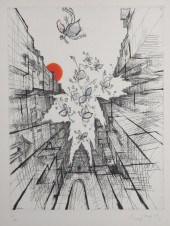 RONALD WILLIAM FORDHAM SEARLE,
RONALD WILLIAM FORDHAM SEARLE, NEW YORK / ENGLAND, FRANCE (1920-2011), BAD NEWS, 1970, LITHOGRAPH, 30"H X 22"WRonald William Fordham Searle, New York / England, France, (1920-2011) Bad News, 1970, lithograph Titled and numbered 26/99 lower left, signed and dated lower right. Biography from the Archives of askART: Ronald William Fordham Searle, CBE, RDI, (born 3 March 1920, Cambridge, England) is an influential English artist and cartoonist. Best known as the creator of St Trinian's School (the subject of several books and seven full-length films). He is also the co-author (with Geoffrey Willans) of the Molesworth tetralogy. Searle was born in Cambridge where his father was a porter at Cambridge Railway Station. He started drawing at the age of five and left school at the age of 15. In April 1939, realizing that war was inevitable, he abandoned his art studies to enlist in the Royal Engineers. He trained at Cambridge College of Arts and Technology, currently Anglia Ruskin University, for two years, and in 1941, published the first St Trinian's cartoon in the magazine Lilliput. In January 1942 he was stationed in Singapore. After a month of fighting in Malaya, Singapore fell to the Japanese, and he was taken prisoner along with his cousin Tom Fordham Searle. He spent the rest of the war a prisoner, first in Changi Prison and then in the Kwai jungle, working on the Siam-Burma Death Railway. The brutal camp conditions were documented by Searle in a series of drawings that he hid under the mattresses of prisoners dying of cholera. Liberated late in 1945, Searle returned to England where he published several of the surviving drawings in fellow prisoner Russell Braddon's The Naked Island. Most of these drawings appear in his 1986 book, Ronald Searle: To the Kwai and Back, War Drawings 1939-1945. At least one of the drawings is on display at the Changi Museum and Chapel, Singapore, but the majority of these original drawings, approximately 300, are in the permanent collection of the Imperial War Museum, London, along with the works of other POW artists. The best known of these are Jack Bridger Chalker, Philip Meninsky and Ashley George Old. He married the journalist Kaye Webb in 1947; they had twins, Kate and Johnny. Searle produced an extraordinary volume of work during the 1950s, including drawings for Life, Holiday and Punch. His cartoons appeared in The New Yorker, the Sunday Express and the News Chronicle. He compiled more St Trinian's books, which were based on his sister's school and other girls' schools in Cambridge, and collaborated with Geoffrey Willans on the Molesworth books (Down With Skool!, 1953, and How to be Topp, 1954), and with Alex Atkinson on travel books; and did animation in Hollywood and worked on advertisements and posters. Searle also drew the title backgrounds of the Sidney Gilliat and Frank Launder film The Happiest Days of Your Life. In 1961 he moved to Paris, leaving his family and later marrying Monica Koenig, theatre designer and creator of necklaces. In France he worked more on reportage for Life and Holiday and less on cartoons. He also continued to work in a broad range of media, and produced books (including his well-known cat books), animated films and sculpture for commemorative medals, both for the French Mint and the British Art Medal Society. Searle did a considerable amount of designing for the cinema and in 1965, he completed the opening, intermission and closing credits for the popular comedy Those Magnificent Men in Their Flying Machines. In 1975 the full-length cartoon Dick Deadeye was released. Animated by a number of artists both British and French, it is considered by some to be his greatest achievement, although Searle himself detested the result. Since 1975 he and Monica have lived and worked in the mountains of Haute Provence. In 2010 he gave about 2,200 of his works as permanent loans to Wilhelm Busch Museum Hannover (Germany) now renamed Deutsches Museum für Karikatur und Zeichenkunst, the ancient Summer palace of George 1st, that holds Searle's archives. Searle received much recognition for his work, especially in America, including the National Cartoonist Society Advertising and Illustration Award in 1959 and 1965, the Reuben Award in 1960, their Illustration Award in 1980 and their Advertising Award in 1986 and 1987. His work has had a great deal of influence, particularly on American cartoonists, including Pat Oliphant, Matt Groening, Hilary Knight and the animators of Disney's 101 Dalmatians. In 2005 he was the subject of a long BBC documentary on his life and work by Russell Davies. In 2007 he was decorated with France's highest award, the Légion d'honneur and in 2009 he received the German Order of Merit. lithograph Dimensions: 30"H x 22"W
RONALD WILLIAM FORDHAM SEARLE,
RONALD WILLIAM FORDHAM SEARLE, NEW YORK / ENGLAND, FRANCE (1920-2011), BAD NEWS, 1970, LITHOGRAPH, 30"H X 22"WRonald William Fordham Searle, New York / England, France, (1920-2011) Bad News, 1970, lithograph Titled and numbered 26/99 lower left, signed and dated lower right. Biography from the Archives of askART: Ronald William Fordham Searle, CBE, RDI, (born 3 March 1920, Cambridge, England) is an influential English artist and cartoonist. Best known as the creator of St Trinian's School (the subject of several books and seven full-length films). He is also the co-author (with Geoffrey Willans) of the Molesworth tetralogy. Searle was born in Cambridge where his father was a porter at Cambridge Railway Station. He started drawing at the age of five and left school at the age of 15. In April 1939, realizing that war was inevitable, he abandoned his art studies to enlist in the Royal Engineers. He trained at Cambridge College of Arts and Technology, currently Anglia Ruskin University, for two years, and in 1941, published the first St Trinian's cartoon in the magazine Lilliput. In January 1942 he was stationed in Singapore. After a month of fighting in Malaya, Singapore fell to the Japanese, and he was taken prisoner along with his cousin Tom Fordham Searle. He spent the rest of the war a prisoner, first in Changi Prison and then in the Kwai jungle, working on the Siam-Burma Death Railway. The brutal camp conditions were documented by Searle in a series of drawings that he hid under the mattresses of prisoners dying of cholera. Liberated late in 1945, Searle returned to England where he published several of the surviving drawings in fellow prisoner Russell Braddon's The Naked Island. Most of these drawings appear in his 1986 book, Ronald Searle: To the Kwai and Back, War Drawings 1939-1945. At least one of the drawings is on display at the Changi Museum and Chapel, Singapore, but the majority of these original drawings, approximately 300, are in the permanent collection of the Imperial War Museum, London, along with the works of other POW artists. The best known of these are Jack Bridger Chalker, Philip Meninsky and Ashley George Old. He married the journalist Kaye Webb in 1947; they had twins, Kate and Johnny. Searle produced an extraordinary volume of work during the 1950s, including drawings for Life, Holiday and Punch. His cartoons appeared in The New Yorker, the Sunday Express and the News Chronicle. He compiled more St Trinian's books, which were based on his sister's school and other girls' schools in Cambridge, and collaborated with Geoffrey Willans on the Molesworth books (Down With Skool!, 1953, and How to be Topp, 1954), and with Alex Atkinson on travel books; and did animation in Hollywood and worked on advertisements and posters. Searle also drew the title backgrounds of the Sidney Gilliat and Frank Launder film The Happiest Days of Your Life. In 1961 he moved to Paris, leaving his family and later marrying Monica Koenig, theatre designer and creator of necklaces. In France he worked more on reportage for Life and Holiday and less on cartoons. He also continued to work in a broad range of media, and produced books (including his well-known cat books), animated films and sculpture for commemorative medals, both for the French Mint and the British Art Medal Society. Searle did a considerable amount of designing for the cinema and in 1965, he completed the opening, intermission and closing credits for the popular comedy Those Magnificent Men in Their Flying Machines. In 1975 the full-length cartoon Dick Deadeye was released. Animated by a number of artists both British and French, it is considered by some to be his greatest achievement, although Searle himself detested the result. Since 1975 he and Monica have lived and worked in the mountains of Haute Provence. In 2010 he gave about 2,200 of his works as permanent loans to Wilhelm Busch Museum Hannover (Germany) now renamed Deutsches Museum für Karikatur und Zeichenkunst, the ancient Summer palace of George 1st, that holds Searle's archives. Searle received much recognition for his work, especially in America, including the National Cartoonist Society Advertising and Illustration Award in 1959 and 1965, the Reuben Award in 1960, their Illustration Award in 1980 and their Advertising Award in 1986 and 1987. His work has had a great deal of influence, particularly on American cartoonists, including Pat Oliphant, Matt Groening, Hilary Knight and the animators of Disney's 101 Dalmatians. In 2005 he was the subject of a long BBC documentary on his life and work by Russell Davies. In 2007 he was decorated with France's highest award, the Légion d'honneur and in 2009 he received the German Order of Merit. lithograph Dimensions: 30"H x 22"W -
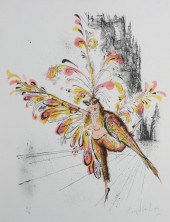 RONALD WILLIAM FORDHAM SEARLE,
RONALD WILLIAM FORDHAM SEARLE, NEW YORK / ENGLAND, FRANCE (1920-2011), CITY BIRD, 1969, LITHOGRAPH, 26"H X 19 1/2"WRonald William Fordham Searle, New York / England, France, (1920-2011) City Bird, 1969, lithograph Signed and dated lower right, numbered 52/99 lower left. Titled verso. Biography from the Archives of askART: Ronald William Fordham Searle, CBE, RDI, (born 3 March 1920, Cambridge, England) is an influential English artist and cartoonist. Best known as the creator of St Trinian's School (the subject of several books and seven full-length films). He is also the co-author (with Geoffrey Willans) of the Molesworth tetralogy. Searle was born in Cambridge where his father was a porter at Cambridge Railway Station. He started drawing at the age of five and left school at the age of 15. In April 1939, realizing that war was inevitable, he abandoned his art studies to enlist in the Royal Engineers. He trained at Cambridge College of Arts and Technology, currently Anglia Ruskin University, for two years, and in 1941, published the first St Trinian's cartoon in the magazine Lilliput. In January 1942 he was stationed in Singapore. After a month of fighting in Malaya, Singapore fell to the Japanese, and he was taken prisoner along with his cousin Tom Fordham Searle. He spent the rest of the war a prisoner, first in Changi Prison and then in the Kwai jungle, working on the Siam-Burma Death Railway. The brutal camp conditions were documented by Searle in a series of drawings that he hid under the mattresses of prisoners dying of cholera. Liberated late in 1945, Searle returned to England where he published several of the surviving drawings in fellow prisoner Russell Braddon's The Naked Island. Most of these drawings appear in his 1986 book, Ronald Searle: To the Kwai and Back, War Drawings 1939-1945. At least one of the drawings is on display at the Changi Museum and Chapel, Singapore, but the majority of these original drawings, approximately 300, are in the permanent collection of the Imperial War Museum, London, along with the works of other POW artists. The best known of these are Jack Bridger Chalker, Philip Meninsky and Ashley George Old. He married the journalist Kaye Webb in 1947; they had twins, Kate and Johnny. Searle produced an extraordinary volume of work during the 1950s, including drawings for Life, Holiday and Punch. His cartoons appeared in The New Yorker, the Sunday Express and the News Chronicle. He compiled more St Trinian's books, which were based on his sister's school and other girls' schools in Cambridge, and collaborated with Geoffrey Willans on the Molesworth books (Down With Skool!, 1953, and How to be Topp, 1954), and with Alex Atkinson on travel books; and did animation in Hollywood and worked on advertisements and posters. Searle also drew the title backgrounds of the Sidney Gilliat and Frank Launder film The Happiest Days of Your Life. In 1961 he moved to Paris, leaving his family and later marrying Monica Koenig, theatre designer and creator of necklaces. In France he worked more on reportage for Life and Holiday and less on cartoons. He also continued to work in a broad range of media, and produced books (including his well-known cat books), animated films and sculpture for commemorative medals, both for the French Mint and the British Art Medal Society. Searle did a considerable amount of designing for the cinema and in 1965, he completed the opening, intermission and closing credits for the popular comedy Those Magnificent Men in Their Flying Machines. In 1975 the full-length cartoon Dick Deadeye was released. Animated by a number of artists both British and French, it is considered by some to be his greatest achievement, although Searle himself detested the result. Since 1975 he and Monica have lived and worked in the mountains of Haute Provence. In 2010 he gave about 2,200 of his works as permanent loans to Wilhelm Busch Museum Hannover (Germany) now renamed Deutsches Museum für Karikatur und Zeichenkunst, the ancient Summer palace of George 1st, that holds Searle's archives. Searle received much recognition for his work, especially in America, including the National Cartoonist Society Advertising and Illustration Award in 1959 and 1965, the Reuben Award in 1960, their Illustration Award in 1980 and their Advertising Award in 1986 and 1987. His work has had a great deal of influence, particularly on American cartoonists, including Pat Oliphant, Matt Groening, Hilary Knight and the animators of Disney's 101 Dalmatians. In 2005 he was the subject of a long BBC documentary on his life and work by Russell Davies. In 2007 he was decorated with France's highest award, the Légion d'honneur and in 2009 he received the German Order of Merit. lithograph Dimensions: 26"H x 19 1/2"W
RONALD WILLIAM FORDHAM SEARLE,
RONALD WILLIAM FORDHAM SEARLE, NEW YORK / ENGLAND, FRANCE (1920-2011), CITY BIRD, 1969, LITHOGRAPH, 26"H X 19 1/2"WRonald William Fordham Searle, New York / England, France, (1920-2011) City Bird, 1969, lithograph Signed and dated lower right, numbered 52/99 lower left. Titled verso. Biography from the Archives of askART: Ronald William Fordham Searle, CBE, RDI, (born 3 March 1920, Cambridge, England) is an influential English artist and cartoonist. Best known as the creator of St Trinian's School (the subject of several books and seven full-length films). He is also the co-author (with Geoffrey Willans) of the Molesworth tetralogy. Searle was born in Cambridge where his father was a porter at Cambridge Railway Station. He started drawing at the age of five and left school at the age of 15. In April 1939, realizing that war was inevitable, he abandoned his art studies to enlist in the Royal Engineers. He trained at Cambridge College of Arts and Technology, currently Anglia Ruskin University, for two years, and in 1941, published the first St Trinian's cartoon in the magazine Lilliput. In January 1942 he was stationed in Singapore. After a month of fighting in Malaya, Singapore fell to the Japanese, and he was taken prisoner along with his cousin Tom Fordham Searle. He spent the rest of the war a prisoner, first in Changi Prison and then in the Kwai jungle, working on the Siam-Burma Death Railway. The brutal camp conditions were documented by Searle in a series of drawings that he hid under the mattresses of prisoners dying of cholera. Liberated late in 1945, Searle returned to England where he published several of the surviving drawings in fellow prisoner Russell Braddon's The Naked Island. Most of these drawings appear in his 1986 book, Ronald Searle: To the Kwai and Back, War Drawings 1939-1945. At least one of the drawings is on display at the Changi Museum and Chapel, Singapore, but the majority of these original drawings, approximately 300, are in the permanent collection of the Imperial War Museum, London, along with the works of other POW artists. The best known of these are Jack Bridger Chalker, Philip Meninsky and Ashley George Old. He married the journalist Kaye Webb in 1947; they had twins, Kate and Johnny. Searle produced an extraordinary volume of work during the 1950s, including drawings for Life, Holiday and Punch. His cartoons appeared in The New Yorker, the Sunday Express and the News Chronicle. He compiled more St Trinian's books, which were based on his sister's school and other girls' schools in Cambridge, and collaborated with Geoffrey Willans on the Molesworth books (Down With Skool!, 1953, and How to be Topp, 1954), and with Alex Atkinson on travel books; and did animation in Hollywood and worked on advertisements and posters. Searle also drew the title backgrounds of the Sidney Gilliat and Frank Launder film The Happiest Days of Your Life. In 1961 he moved to Paris, leaving his family and later marrying Monica Koenig, theatre designer and creator of necklaces. In France he worked more on reportage for Life and Holiday and less on cartoons. He also continued to work in a broad range of media, and produced books (including his well-known cat books), animated films and sculpture for commemorative medals, both for the French Mint and the British Art Medal Society. Searle did a considerable amount of designing for the cinema and in 1965, he completed the opening, intermission and closing credits for the popular comedy Those Magnificent Men in Their Flying Machines. In 1975 the full-length cartoon Dick Deadeye was released. Animated by a number of artists both British and French, it is considered by some to be his greatest achievement, although Searle himself detested the result. Since 1975 he and Monica have lived and worked in the mountains of Haute Provence. In 2010 he gave about 2,200 of his works as permanent loans to Wilhelm Busch Museum Hannover (Germany) now renamed Deutsches Museum für Karikatur und Zeichenkunst, the ancient Summer palace of George 1st, that holds Searle's archives. Searle received much recognition for his work, especially in America, including the National Cartoonist Society Advertising and Illustration Award in 1959 and 1965, the Reuben Award in 1960, their Illustration Award in 1980 and their Advertising Award in 1986 and 1987. His work has had a great deal of influence, particularly on American cartoonists, including Pat Oliphant, Matt Groening, Hilary Knight and the animators of Disney's 101 Dalmatians. In 2005 he was the subject of a long BBC documentary on his life and work by Russell Davies. In 2007 he was decorated with France's highest award, the Légion d'honneur and in 2009 he received the German Order of Merit. lithograph Dimensions: 26"H x 19 1/2"W -
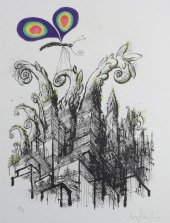 RONALD WILLIAM FORDHAM SEARLE,
RONALD WILLIAM FORDHAM SEARLE, NEW YORK / ENGLAND, FRANCE (1920-2011), VEGETABLE CITY, 1969, LITHOGRAPH, 26"H X 20"WRonald William Fordham Searle, New York / England, France, (1920-2011) Vegetable City, 1969, lithograph Numbered 28/99 lower left, titled lower middle, signed and dated lower right. Biography from the Archives of askART: Ronald William Fordham Searle, CBE, RDI, (born 3 March 1920, Cambridge, England) is an influential English artist and cartoonist. Best known as the creator of St Trinian's School (the subject of several books and seven full-length films). He is also the co-author (with Geoffrey Willans) of the Molesworth tetralogy. Searle was born in Cambridge where his father was a porter at Cambridge Railway Station. He started drawing at the age of five and left school at the age of 15. In April 1939, realizing that war was inevitable, he abandoned his art studies to enlist in the Royal Engineers. He trained at Cambridge College of Arts and Technology, currently Anglia Ruskin University, for two years, and in 1941, published the first St Trinian's cartoon in the magazine Lilliput. In January 1942 he was stationed in Singapore. After a month of fighting in Malaya, Singapore fell to the Japanese, and he was taken prisoner along with his cousin Tom Fordham Searle. He spent the rest of the war a prisoner, first in Changi Prison and then in the Kwai jungle, working on the Siam-Burma Death Railway. The brutal camp conditions were documented by Searle in a series of drawings that he hid under the mattresses of prisoners dying of cholera. Liberated late in 1945, Searle returned to England where he published several of the surviving drawings in fellow prisoner Russell Braddon's The Naked Island. Most of these drawings appear in his 1986 book, Ronald Searle: To the Kwai and Back, War Drawings 1939-1945. At least one of the drawings is on display at the Changi Museum and Chapel, Singapore, but the majority of these original drawings, approximately 300, are in the permanent collection of the Imperial War Museum, London, along with the works of other POW artists. The best known of these are Jack Bridger Chalker, Philip Meninsky and Ashley George Old. He married the journalist Kaye Webb in 1947; they had twins, Kate and Johnny. Searle produced an extraordinary volume of work during the 1950s, including drawings for Life, Holiday and Punch. His cartoons appeared in The New Yorker, the Sunday Express and the News Chronicle. He compiled more St Trinian's books, which were based on his sister's school and other girls' schools in Cambridge, and collaborated with Geoffrey Willans on the Molesworth books (Down With Skool!, 1953, and How to be Topp, 1954), and with Alex Atkinson on travel books; and did animation in Hollywood and worked on advertisements and posters. Searle also drew the title backgrounds of the Sidney Gilliat and Frank Launder film The Happiest Days of Your Life. In 1961 he moved to Paris, leaving his family and later marrying Monica Koenig, theatre designer and creator of necklaces. In France he worked more on reportage for Life and Holiday and less on cartoons. He also continued to work in a broad range of media, and produced books (including his well-known cat books), animated films and sculpture for commemorative medals, both for the French Mint and the British Art Medal Society. Searle did a considerable amount of designing for the cinema and in 1965, he completed the opening, intermission and closing credits for the popular comedy Those Magnificent Men in Their Flying Machines. In 1975 the full-length cartoon Dick Deadeye was released. Animated by a number of artists both British and French, it is considered by some to be his greatest achievement, although Searle himself detested the result. Since 1975 he and Monica have lived and worked in the mountains of Haute Provence. In 2010 he gave about 2,200 of his works as permanent loans to Wilhelm Busch Museum Hannover (Germany) now renamed Deutsches Museum für Karikatur und Zeichenkunst, the ancient Summer palace of George 1st, that holds Searle's archives. Searle received much recognition for his work, especially in America, including the National Cartoonist Society Advertising and Illustration Award in 1959 and 1965, the Reuben Award in 1960, their Illustration Award in 1980 and their Advertising Award in 1986 and 1987. His work has had a great deal of influence, particularly on American cartoonists, including Pat Oliphant, Matt Groening, Hilary Knight and the animators of Disney's 101 Dalmatians. In 2005 he was the subject of a long BBC documentary on his life and work by Russell Davies. In 2007 he was decorated with France's highest award, the Légion d'honneur and in 2009 he received the German Order of Merit. lithograph Dimensions: 26"H x 20"W
RONALD WILLIAM FORDHAM SEARLE,
RONALD WILLIAM FORDHAM SEARLE, NEW YORK / ENGLAND, FRANCE (1920-2011), VEGETABLE CITY, 1969, LITHOGRAPH, 26"H X 20"WRonald William Fordham Searle, New York / England, France, (1920-2011) Vegetable City, 1969, lithograph Numbered 28/99 lower left, titled lower middle, signed and dated lower right. Biography from the Archives of askART: Ronald William Fordham Searle, CBE, RDI, (born 3 March 1920, Cambridge, England) is an influential English artist and cartoonist. Best known as the creator of St Trinian's School (the subject of several books and seven full-length films). He is also the co-author (with Geoffrey Willans) of the Molesworth tetralogy. Searle was born in Cambridge where his father was a porter at Cambridge Railway Station. He started drawing at the age of five and left school at the age of 15. In April 1939, realizing that war was inevitable, he abandoned his art studies to enlist in the Royal Engineers. He trained at Cambridge College of Arts and Technology, currently Anglia Ruskin University, for two years, and in 1941, published the first St Trinian's cartoon in the magazine Lilliput. In January 1942 he was stationed in Singapore. After a month of fighting in Malaya, Singapore fell to the Japanese, and he was taken prisoner along with his cousin Tom Fordham Searle. He spent the rest of the war a prisoner, first in Changi Prison and then in the Kwai jungle, working on the Siam-Burma Death Railway. The brutal camp conditions were documented by Searle in a series of drawings that he hid under the mattresses of prisoners dying of cholera. Liberated late in 1945, Searle returned to England where he published several of the surviving drawings in fellow prisoner Russell Braddon's The Naked Island. Most of these drawings appear in his 1986 book, Ronald Searle: To the Kwai and Back, War Drawings 1939-1945. At least one of the drawings is on display at the Changi Museum and Chapel, Singapore, but the majority of these original drawings, approximately 300, are in the permanent collection of the Imperial War Museum, London, along with the works of other POW artists. The best known of these are Jack Bridger Chalker, Philip Meninsky and Ashley George Old. He married the journalist Kaye Webb in 1947; they had twins, Kate and Johnny. Searle produced an extraordinary volume of work during the 1950s, including drawings for Life, Holiday and Punch. His cartoons appeared in The New Yorker, the Sunday Express and the News Chronicle. He compiled more St Trinian's books, which were based on his sister's school and other girls' schools in Cambridge, and collaborated with Geoffrey Willans on the Molesworth books (Down With Skool!, 1953, and How to be Topp, 1954), and with Alex Atkinson on travel books; and did animation in Hollywood and worked on advertisements and posters. Searle also drew the title backgrounds of the Sidney Gilliat and Frank Launder film The Happiest Days of Your Life. In 1961 he moved to Paris, leaving his family and later marrying Monica Koenig, theatre designer and creator of necklaces. In France he worked more on reportage for Life and Holiday and less on cartoons. He also continued to work in a broad range of media, and produced books (including his well-known cat books), animated films and sculpture for commemorative medals, both for the French Mint and the British Art Medal Society. Searle did a considerable amount of designing for the cinema and in 1965, he completed the opening, intermission and closing credits for the popular comedy Those Magnificent Men in Their Flying Machines. In 1975 the full-length cartoon Dick Deadeye was released. Animated by a number of artists both British and French, it is considered by some to be his greatest achievement, although Searle himself detested the result. Since 1975 he and Monica have lived and worked in the mountains of Haute Provence. In 2010 he gave about 2,200 of his works as permanent loans to Wilhelm Busch Museum Hannover (Germany) now renamed Deutsches Museum für Karikatur und Zeichenkunst, the ancient Summer palace of George 1st, that holds Searle's archives. Searle received much recognition for his work, especially in America, including the National Cartoonist Society Advertising and Illustration Award in 1959 and 1965, the Reuben Award in 1960, their Illustration Award in 1980 and their Advertising Award in 1986 and 1987. His work has had a great deal of influence, particularly on American cartoonists, including Pat Oliphant, Matt Groening, Hilary Knight and the animators of Disney's 101 Dalmatians. In 2005 he was the subject of a long BBC documentary on his life and work by Russell Davies. In 2007 he was decorated with France's highest award, the Légion d'honneur and in 2009 he received the German Order of Merit. lithograph Dimensions: 26"H x 20"W -
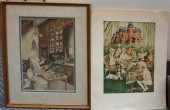 AFTER MARY PETTY, MAID POLISHING
AFTER MARY PETTY, MAID POLISHING SILVER AND FAMILY PORTRAIT, TWO WORKS FROM THE NEW YORKER, 1945 & 1948, PRINTS, 23 X 18 INCHESAfter Mary Petty, Maid Polishing Silver and Family Portrait, Two Works From The New Yorker, 1945 & 1948, Prints, 23 x 18 inches
AFTER MARY PETTY, MAID POLISHING
AFTER MARY PETTY, MAID POLISHING SILVER AND FAMILY PORTRAIT, TWO WORKS FROM THE NEW YORKER, 1945 & 1948, PRINTS, 23 X 18 INCHESAfter Mary Petty, Maid Polishing Silver and Family Portrait, Two Works From The New Yorker, 1945 & 1948, Prints, 23 x 18 inches -
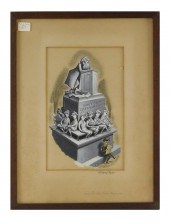 RICHARD TAYLOR (AMERICAN,
RICHARD TAYLOR (AMERICAN, 1902-1970), ORIGINAL NEW YORKER MAGAZINE ILLUSTRATION "DON'T WRITE, SEND A NIGHT LETTER", GOUACHE AND INK...Richard Taylor (American, 1902-1970), original New Yorker Magazine illustration "Don't Write, Send a Night Letter", gouache and ink on paper, depicts a group of men seated around plinth of monument topped by beadered man in spectacles, all depicted in tones of black and white, singular figure at lower right in muted bcolor, artist signed in picture on plinth base "R. Taylor" and on mat in ink at lower right, also inscribed on mat in lower right corner "The New Yorker Magazine", stamped verso "The New Yorker Editorial Department, 25 West 43rd Street", loose in frame, expected toning and minor mat burn, small hole/ damage at upper right, foxing to mat, sold as found, ss: 12 3/4" h. x 8" w.
RICHARD TAYLOR (AMERICAN,
RICHARD TAYLOR (AMERICAN, 1902-1970), ORIGINAL NEW YORKER MAGAZINE ILLUSTRATION "DON'T WRITE, SEND A NIGHT LETTER", GOUACHE AND INK...Richard Taylor (American, 1902-1970), original New Yorker Magazine illustration "Don't Write, Send a Night Letter", gouache and ink on paper, depicts a group of men seated around plinth of monument topped by beadered man in spectacles, all depicted in tones of black and white, singular figure at lower right in muted bcolor, artist signed in picture on plinth base "R. Taylor" and on mat in ink at lower right, also inscribed on mat in lower right corner "The New Yorker Magazine", stamped verso "The New Yorker Editorial Department, 25 West 43rd Street", loose in frame, expected toning and minor mat burn, small hole/ damage at upper right, foxing to mat, sold as found, ss: 12 3/4" h. x 8" w. -
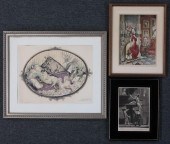 Three prints, to include "Memory
Three prints, to include "Memory Lane", 69/99, signed lower right "L. Satchett", printed by Michel Casse, Paris, framed and matted, sight 19"h x 25"w; a Mary Petty print, published by the New Yorker 1945, sight 16 1/4"h x 11 3/4"w, and "The Adventurous Macaroni, or the Three Jolly Blades, the Efqr. Parfon & Doctor", engraving by Sayer and Bennett, No. 53, London, 1774, framed and matted, sight 14 14"h x 10 1/4"w
Three prints, to include "Memory
Three prints, to include "Memory Lane", 69/99, signed lower right "L. Satchett", printed by Michel Casse, Paris, framed and matted, sight 19"h x 25"w; a Mary Petty print, published by the New Yorker 1945, sight 16 1/4"h x 11 3/4"w, and "The Adventurous Macaroni, or the Three Jolly Blades, the Efqr. Parfon & Doctor", engraving by Sayer and Bennett, No. 53, London, 1774, framed and matted, sight 14 14"h x 10 1/4"w -
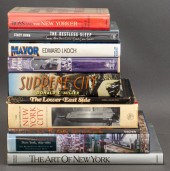 NEW YORK BOOK GROUP, 10 Group of
NEW YORK BOOK GROUP, 10 Group of ten books of New York City interest, and comprising: Donald L. Miller, Supreme City, Simon & Schuster: New York, 2014; Dale Kramer, Ross and the New Yorker, Doubleday: Garden City, 1951; Stacy Horn, The Restless Sleep: Inside NYC's Cold Case Squad, Viking: New York, 2005; Edward I. Koch, Mayor: An Autobiography, Simon & Schuster: New York, 1984; Kate Simon: Fifth Avenue: A very Social History, Harcourt Brace Jovanovich: New York, 1978; Christo and Jeanne Claude, The Gates...1979-2005, Taschen: New York, 2005; Kenneth T. Jackson, The Encyclopedia of New York City, Yale University Press: New Haven, 1995; chwast and Heller (eds.), The Art of New York, Abrams: New York, 1983; Diana Cavallo, The Lower East Side, Crowell-Collier Press, 1971; and Voorsanger & Howat (eds) Art and The Empire City, Metropolitan Museum / Yale: New York New Haven, 2000. Largest: 13.5" H x 10.5" W.
NEW YORK BOOK GROUP, 10 Group of
NEW YORK BOOK GROUP, 10 Group of ten books of New York City interest, and comprising: Donald L. Miller, Supreme City, Simon & Schuster: New York, 2014; Dale Kramer, Ross and the New Yorker, Doubleday: Garden City, 1951; Stacy Horn, The Restless Sleep: Inside NYC's Cold Case Squad, Viking: New York, 2005; Edward I. Koch, Mayor: An Autobiography, Simon & Schuster: New York, 1984; Kate Simon: Fifth Avenue: A very Social History, Harcourt Brace Jovanovich: New York, 1978; Christo and Jeanne Claude, The Gates...1979-2005, Taschen: New York, 2005; Kenneth T. Jackson, The Encyclopedia of New York City, Yale University Press: New Haven, 1995; chwast and Heller (eds.), The Art of New York, Abrams: New York, 1983; Diana Cavallo, The Lower East Side, Crowell-Collier Press, 1971; and Voorsanger & Howat (eds) Art and The Empire City, Metropolitan Museum / Yale: New York New Haven, 2000. Largest: 13.5" H x 10.5" W. -
 MISCHA RICHTER (1910-2001), "WHO
MISCHA RICHTER (1910-2001), "WHO SAYS JEFF HAS NO SENSE OF HUMOR," EACH: INK ON PAPER, SIGHT OF FIRST: 11" H X 10" W; SHEET OF SECOND: 10.5" H X 12" WMischa Richter, (1910-2001) "Who Says Jeff Has No Sense of Humor", Each: Ink on paper Signed in ink on the right sheet, lower right: Richter; dated and annotated, presumably in another hand, and with The New York editorial department red ink stamp, and copyright card of The New Yorker Magazine, Inc., 1974, all on two sheets of paper, affixed verso: 4/29/74 / Ribbon Cutting / Line of Copper Each: Ink on paper Dimensions: Sheet of first: 11" H x 10" W; Sheet of second: 10.5" H x 12" W Provenance: Collection of Howard and Barbara Wise, New York, NY David Wise and Audry Taylor, Los Angeles, CA, by descent from the above
MISCHA RICHTER (1910-2001), "WHO
MISCHA RICHTER (1910-2001), "WHO SAYS JEFF HAS NO SENSE OF HUMOR," EACH: INK ON PAPER, SIGHT OF FIRST: 11" H X 10" W; SHEET OF SECOND: 10.5" H X 12" WMischa Richter, (1910-2001) "Who Says Jeff Has No Sense of Humor", Each: Ink on paper Signed in ink on the right sheet, lower right: Richter; dated and annotated, presumably in another hand, and with The New York editorial department red ink stamp, and copyright card of The New Yorker Magazine, Inc., 1974, all on two sheets of paper, affixed verso: 4/29/74 / Ribbon Cutting / Line of Copper Each: Ink on paper Dimensions: Sheet of first: 11" H x 10" W; Sheet of second: 10.5" H x 12" W Provenance: Collection of Howard and Barbara Wise, New York, NY David Wise and Audry Taylor, Los Angeles, CA, by descent from the above -
 COLLECTION OF ASSORTED 'THE NEW
COLLECTION OF ASSORTED 'THE NEW YORKER' MAGAZINE COVERSCollection of Assorted 'The New Yorker' Magazine Covers,,
COLLECTION OF ASSORTED 'THE NEW
COLLECTION OF ASSORTED 'THE NEW YORKER' MAGAZINE COVERSCollection of Assorted 'The New Yorker' Magazine Covers,, -
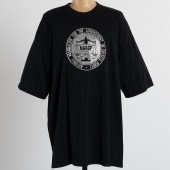 GROUP OF BLACK BEDAZZLED NAACP
GROUP OF BLACK BEDAZZLED NAACP T-SHIRTSComprising ten crew neck, short-sleeved black cotton t-shirts, with circular NAACP blazon across chest and initials "ALT" or full name "Andre Leon Talley" picked out in black, silver, or gold faceted appliques; together with a single example with praying hands symbol and "born blessed" across chest, "J. Matthews Collection" at proper left front hem. (11 total). All with manufacturer tags, and size 5XL or 6XL. Note: André wore one of these t-shirts to the New Yorkers for Children Spring Dinner Dance at the Mandarin Oriental Hotel on April 8, 2010 in New York City, and to speak on a panel celebrating the premier of the documentary "Ultrasuede: In Search of Halston" during the 2010 Tribeca Film Festival at the School of Visual Arts on April 30, 2010. Condition In good overall condition. Not withstanding this report or any discussion concerning condition of a lot, all lots are offered and sold "as is" in accordance with our conditions of sale.
GROUP OF BLACK BEDAZZLED NAACP
GROUP OF BLACK BEDAZZLED NAACP T-SHIRTSComprising ten crew neck, short-sleeved black cotton t-shirts, with circular NAACP blazon across chest and initials "ALT" or full name "Andre Leon Talley" picked out in black, silver, or gold faceted appliques; together with a single example with praying hands symbol and "born blessed" across chest, "J. Matthews Collection" at proper left front hem. (11 total). All with manufacturer tags, and size 5XL or 6XL. Note: André wore one of these t-shirts to the New Yorkers for Children Spring Dinner Dance at the Mandarin Oriental Hotel on April 8, 2010 in New York City, and to speak on a panel celebrating the premier of the documentary "Ultrasuede: In Search of Halston" during the 2010 Tribeca Film Festival at the School of Visual Arts on April 30, 2010. Condition In good overall condition. Not withstanding this report or any discussion concerning condition of a lot, all lots are offered and sold "as is" in accordance with our conditions of sale. -
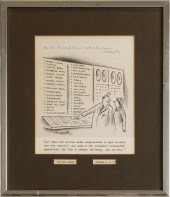 HENRY MARTIN (1925-2020): JUST
HENRY MARTIN (1925-2020): JUST PRESS THE BUTTONS HEREHenry Martin (1925-2020): Just Press the Buttons Here, "Just Press the Buttons Here Corresponding to Your Ailment, and the Printout Will Give Us the Diagnosis..."; cartoon for the New Yorker, February 12, 1972; pen, ink and charcoal on paperboard laid to board (the caption and "Swollen Glands" each written on a separate strip of paper laid down); signed and inscribed in ink "For Dr. Bernard Weiss- best wishes from, H. Martin" Dimensions: Sight: 9 3/4 x 8 in. (24.8 x 20.3 cm.), Frame: 16 3/8 x 13 7/8 in. (41.6 x 35.2 cm.) Condition: Glued down to mat. Framed under glass.
HENRY MARTIN (1925-2020): JUST
HENRY MARTIN (1925-2020): JUST PRESS THE BUTTONS HEREHenry Martin (1925-2020): Just Press the Buttons Here, "Just Press the Buttons Here Corresponding to Your Ailment, and the Printout Will Give Us the Diagnosis..."; cartoon for the New Yorker, February 12, 1972; pen, ink and charcoal on paperboard laid to board (the caption and "Swollen Glands" each written on a separate strip of paper laid down); signed and inscribed in ink "For Dr. Bernard Weiss- best wishes from, H. Martin" Dimensions: Sight: 9 3/4 x 8 in. (24.8 x 20.3 cm.), Frame: 16 3/8 x 13 7/8 in. (41.6 x 35.2 cm.) Condition: Glued down to mat. Framed under glass. -
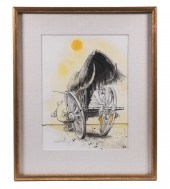 RONALD WILLIAM FORDHAM SEARLE
RONALD WILLIAM FORDHAM SEARLE (NY/UK/FRANCE, 1920-2011) Cartoon of a sweltering individual man riding on the back of an ox cart into a barren desert, his feet dangling in stockings only, his face a misery, ink and watercolor, signed and dated '73. A political cartoon he drew for the New Yorker to go with S.J. Perleman's "Nostalgia in the Middle East". In gilt bullnose frame, linen mat, under plexi, OS: 23" x 1"", SS: 15" x 11 1/2
RONALD WILLIAM FORDHAM SEARLE
RONALD WILLIAM FORDHAM SEARLE (NY/UK/FRANCE, 1920-2011) Cartoon of a sweltering individual man riding on the back of an ox cart into a barren desert, his feet dangling in stockings only, his face a misery, ink and watercolor, signed and dated '73. A political cartoon he drew for the New Yorker to go with S.J. Perleman's "Nostalgia in the Middle East". In gilt bullnose frame, linen mat, under plexi, OS: 23" x 1"", SS: 15" x 11 1/2
...many more examples with full details are available to our members - Learn more


